Applications and Development of Multi-Core Optical Fibers
Abstract
1. Introduction
2. The Application of Multi-Core Fiber in Communications

3. Application of Multi-Core Optical Fibers in Sensing Networks and the Laser Field
3.1. Application of Multi-Core Optical Fibers in Sensing Networks
3.1.1. Engineering Applications
3.1.2. Medical Applications
3.1.3. Aerospace Applications
3.2. The Application of multi-core Optical Fibers in Lasers
4. Manufacturing Techniques for multi-core Optical Fibers
4.1. Tube-in-Rod Grinding Assembling Technique
4.2. Tube-in-Rod Stacking and Assembling Technique
4.3. Combination Method of Tube-and-Rod Drilling
4.4. Other Fabrication Techniques
4.5. Discussion and Prospects of Preparation Methods
5. Conclusions
Author Contributions
Funding
Institutional Review Board Statement
Informed Consent Statement
Data Availability Statement
Conflicts of Interest
References
- Inao, S.; Sato, T.; Sentsui, S.; Kuroha, T.; Nishimura, Y. Multi-core optical fiber. In Proceedings of the Optical Fiber Communication Conference, Washington, DC, USA, 6–8 March 1979; p. WB1. [Google Scholar]
- Yu, S.; He, W. Latest survey on optical fiber communication. Sci. Sin. Inform. 2020, 50, 16. [Google Scholar]
- Nakajima, K.; Sillard, P.; Richardson, D.; Li, M.J.; Essiambre, R.J.; Matsuo, S. Transmission media for an SDM-based optical communication system. IEEE Commun. Mag. 2015, 53, 44–51. [Google Scholar] [CrossRef]
- Richardson, D.J.; Fini, J.M.; Nelson, L.E. Space-division multiplexing in optical fibres. Nat. Photonics 2013, 7, 354–362. [Google Scholar] [CrossRef]
- Desurvire, E.B. Capacity demand and technology challenges for lightwave systems in the next two decades. J. Light. Technol. 2006, 24, 4697–4710. [Google Scholar] [CrossRef]
- Sano, A.; Kobayashi, T.; Yamanaka, S.; Matsuura, A.; Kawakami, H.; Miyamoto, Y.; Ishihara, K.; Masuda, H. 102.3-Tb/s (224 × 548-Gb/s) C- and extended L-band all-Raman transmission over 240 km using PDM-64QAM single carrier FDM with digital pilot tone. In Proceedings of the Optical Fiber Communication Conference and Exposition, Coventry, UK, 2–5 July 2012. [Google Scholar]
- Qian, D.; Huang, M.F.; Ip, E.; Huang, Y.K.; Wang, T. 101.7-Tb/s (370 × 294-Gb/s) PDM-128QAM-OFDM Transmission over 3 × 55-km SSMF using Pilot-based Phase Noise Mitigation. In Proceedings of the 2011 Optical Fiber Communication Conference and Exposition and the National Fiber Optic Engineers Conference, Los Angeles, CA, USA, 06–10 March 2011. [Google Scholar]
- Cisco. Cisco Annual Internet Report (2018–2023) White Paper. Cisco White Pap. 2020, 2018–2023, 1–35. Available online: https://www.cisco.com/c/en/us/solutions/collateral/executive-perspectives/annual-internet-report/white-paper-c11-741490.html (accessed on 27 February 2024).
- Morioka, T. New generation optical infrastructure technologies: “EXAT initiative” towards 2020 and beyond. In Proceedings of the 2009 14th OptoElectronics and Communications Conference, IEEE, Hong Kong, China, 13–17 July 2009; pp. 165–166. [Google Scholar] [CrossRef]
- Nakajima, K.; Matsui, T.; Saito, K.; Sakamoto, T.; Araki, N. Multi-Core Fiber Technology: Next Generation Optical Communication Strategy. IEEE Commun. Stand. Mag. 2017, 1, 38–45. [Google Scholar] [CrossRef]
- Nakajima, K.; Matsui, T.; Saito, K.; Sakamoto, T.; Araki, N. Space division multiplexing technology: Next generation optical communication strategy. In Proceedings of the 2016 ITU Kaleidoscope: ICTs for a Sustainable World (ITU WT), Bangkok, Thailand, 14–16 November 2016; pp. 1–7. [Google Scholar] [CrossRef]
- Le Noane, G. Ultra high density cables using a new concept of bunched multi-core monomode fibers: A key for the future FTTH networks. In Proceedings of the 43rd International Wire and Cable Symposium (IWCS), Atlanta, GA, USA, 14–17 November 1994; pp. 203–210. [Google Scholar]
- Sakaguchi, J.; Awaji, Y.; Wada, N.; Kanno, A.; Watanabe, M. 109-Tb/s (7 × 97 × 172-Gb/s SDM/WDM/PDM) QPSK transmission through 16.8-km homogeneous multi-core fiber. In Proceedings of the Optical Fiber Communication Conference (OFC), Los Angeles, CA, USA, 6–10 March 2011. [Google Scholar]
- Zhu, B.; Taunay, T.F.; Fishteyn, M.; Liu, X.; Chandrasekhar, S.; Yan, M.F.; Fini, J.M.; Monberg, E.M.; Dimarcello, F.V. 112-Tb/s Space-division multiplexed DWDM transmission with 14-b/s/Hz aggregate spectral efficiency over a 76.8-km seven-core fiber. Opt. Express 2011, 19, 16665–16671. [Google Scholar] [CrossRef] [PubMed]
- Sakaguchi, J.; Puttnam, B.J.; Klaus, W.; Awaji, Y.; Kobayashi, T. 19-core fiber transmission of 19x100x172-Gb/s SDM-WDM-PDM-QPSK signals at 305Tb/s. In Proceedings of the National Fiber Optic Engineers Conference, Los Angeles, CA, USA, 4–8 March 2012. [Google Scholar]
- Takara, H.; Sano, A.; Kobayashi, T.; Kubota, H.; Morioka, T. 1.01-Pb/s (12 SDM/222 WDM/456 Gb/s) Crosstalk-managed Transmission with 91.4-b/s/Hz Aggregate Spectral Efficiency. In Proceedings of the European Conference and Exhibition on Optical Communication (ECOC), London, UK, 22–26 September 2012. [Google Scholar]
- Li, A.; Amin, A.A.; Chen, X.; Shieh, W. Transmission of 107-Gb/s mode and polarization multiplexed CO-OFDM signal over a two-mode fiber. Opt. Express 2011, 19, 8808–8814. [Google Scholar] [CrossRef] [PubMed]
- Qian, D.; Ip, E.; Huang, M.F.; Li, M.; Dogariu, A.; Zhang, S.; Yin, S.; Huang, Y.K.; Zhang, Y.; Cheng, X. 1.05 Pb/s Transmission with 109 b/s/Hz Spectral Efficiency using Hybrid Single- and Few-Mode Cores. In Proceedings of the Frontiers in Optics, Frontiers in Optics, Rochester, NY, USA, 14–18 October 2012. [Google Scholar]
- Puttnam, B.J.; Luis, R.S.; Klaus, W.; Sakaguchi, J.; Mendinueta, J.M.D.; Awaji, Y.; Wada, N.; Tamura, Y.; Hayashi, T.; Hirano, M.; et al. 2.15 Pb/s transmission using a 22 core homogeneous single-mode multi-core fiber and wideband optical comb. In Proceedings of the 2015 European Conference on Optical Communication (ECOC), Valencia, Spain, 27 September–1 October 2015; pp. 1–3. [Google Scholar] [CrossRef]
- Kobayashi, T.; Nakamura, M.; Hamaoka, F.; Shibahara, K.; Morioka, T. 1-Pb/s (32 SDM/46 WDM/768 Gb/s) C-band Dense SDM Transmission over 205.6-km of Single-mode Heterogeneous Multi-core Fiber using 96-Gbaud PDM-16QAM Channels. In Proceedings of the 2017 Optical Fiber Communications Conference and Exhibition (OFC), Los Angeles, CA, USA, 19–23 March 2017. [Google Scholar]
- Mizuno, T.; Kobayashi, T.; Takara, H.; Sano, A.; Kawakami, H.; Nakagawa, T.; Miyamoto, Y.; Abe, Y.; Goh, T.; Oguma, M. 12-core × 3-mode Dense Space Division Multiplexed Transmission over 40 km Employing Multi-carrier Signals with Parallel MIMO Equalization. In Proceedings of the Optical Fiber Communication Conference, San Francisco, CA, USA, 9–13 March 2014. [Google Scholar]
- Shibahara, K.; Lee, D.; Kobayashi, T.; Mizuno, T.; Takara, H.; Sano, A.; Kawakami, H.; Miyamoto, Y.; Ono, H.; Oguma, M. Dense SDM (12-Core×3-Mode) Transmission Over 527 km With 33.2-ns Mode-Dispersion Employing Low-Complexity Parallel MIMO Frequency-Domain Equalization. J. Light. Technol. 2016, 34, 196–204. [Google Scholar] [CrossRef]
- Igarashi, K.; Tsuritani, T.; Morita, I.; Suzuki, M. 114 space-division-multiplexed WDM transmission using 6-mode 19-core fibers. In Proceedings of the Photonics Conference, Berlin, Germany, 12–14 March 2015. [Google Scholar]
- Soma, D.; Wakayama, Y.; Beppu, S.; Igarashi, K.; Tsuritani, T.; Taga, H.; Morita, I.; Suzuki, M. 665 and 947b/s/Hz Ultra-highly Aggregate-Spectral-Efficient SDM/WDM Transmission over 6-Mode 19-Core Fibre Using DP-16QAM/64QAM Signals. In Proceedings of the Ecoc -post Deadline Paper European Conference on Optical Communication, Dusseldorf, Germany, 18–22 September 2016. [Google Scholar]
- Suzuki, M.; Soma, D.; Igarashi, K.; Wakayama, Y.; Morita, I. Ultra-dense space division multiplexing technologies towards multi-Peta bit/s optical transmission. In Proceedings of the 2016 18th International Conference on Transparent Optical Networks (ICTON), Lucerne, Switzerland, 24–26 May 1989. [Google Scholar]
- Soma, D.; Wakayama, Y.; Beppu, S.; Sumita, S.; Tsuritani, T.; Hayashi, T.; Nagashima, T.; Suzuki, M.; Yoshida, M.; Kasai, K. 10.16-Peta-B/s Dense SDM/WDM Transmission Over 6-Mode 19-Core Fiber Across the C+L Band. J. Light. Technol. 2018, 36, 1362–1368. [Google Scholar] [CrossRef]
- Rademacher, G.; Puttnam, B.J.; Luis, R.S.; Sakaguchi, J.; Furukawa, H. Multi-Span Transmission over 65 km 38-Core 3-Mode Fiber. In Proceedings of the 2020 European Conference on Optical Communications (ECOC), Brussels, Belgium, 6–10 December 2020. [Google Scholar]
- Rademacher, G.; Puttnam, B.J.; Luís, R.; Sakaguchi, J.; Klaus, W.; Eriksson, T.A.; Awaji, Y.; Hayashi, T.; Nagashima, T.; Nakanishi, T. 10.66 Peta-Bit/s Transmission over a 38-Core-Three-Mode Fiber. In Proceedings of the 2020 Optical Fiber Communications Conference and Exhibition (OFC), San Diego, CA, USA, 8–12 March 2020. [Google Scholar]
- Yan, H.; Zhang, W.; Wang, Y.; Bai, Y.; Liu, H.; Sun, W.; Lao, X.; Zhang, G.; Yao, Y.; Cai, Z.; et al. 109.6 Tb/s Real-time SDM Transmission over 2024-km 125-μ Cladding Diameter Weakly Coupled 4-Core MCF. In Proceedings of the 2022 Asia Communications and Photonics Conference (ACP), Shenzhen, China, 5–8 November 2022; pp. 381–384. [Google Scholar] [CrossRef]
- Puttnam, B.J.; Luís, R.S.; Rademacher, G.; Galdino, L.; Lavery, D.; Eriksson, T.A.; Awaji, Y.; Furukawa, H.; Bayvel, P.; Wada, N. 0.61 Pb/s S, C, and L-Band Transmission in a 125μ Diameter 4-Core Fiber Using a Single Wideband Comb Source. J. Light. Technol. 2021, 39, 1027–1032. [Google Scholar] [CrossRef]
- Sleiffer, V.A.J.M.; Jung, Y.; Veljanovski, V.; Van Uden, R.G.H.; Kuschnerov, M.; Chen, H.; Inan, B.; Nielsen, L.G.; Sun, Y.; Richardson, D.J.; et al. 73.7 Tb/s (96 × 3 × 256-Gb/s) mode-division-multiplexed DP-16QAM transmission with inline MM-EDFA. Opt. Express 2012, 20, B428–B438. [Google Scholar] [CrossRef]
- Ryf, R.; Fontaine, N.; Chen, H.; Gnauck, A.; Richardson, D. 72 Tb/s transmission over 179km all-fiber 6 mode span with two cladding pumped in-line amplifiers. In Proceedings of the 41st European Conference of Optical Communication (ECOC 15), Valencia, Spain, 27 September–1 October 2015. [Google Scholar]
- Soma, D.; Beppu, S.; Wakayama, Y.; Yu, K.; Igarashi, K.; Tsuritani, T. 257-Tbit/s Partial MIMO-based 10-Mode C+L-band WDM Transmission over 48-km FMF. In Proceedings of the 2017 European Conference on Optical Communication (ECOC), Gothenburg, Sweden, 17–21 September 2017. [Google Scholar]
- Ryf, R.; Fontaine, N.K.; Wittek, S.; Choutagunta, K.; Carpenter, J. High-Spectral-Efficiency Mode-Multiplexed Transmission Over Graded-Index Multimode Fiber. In Proceedings of the 2018 European Conference on Optical Communication (ECOC), Roma, Italy, 23–27 September 2018. [Google Scholar]
- Beppu, S.; Soma, D.; Sumita, S.; Wakayama, Y.; Takahashi, H.; Tsuritani, T.; Morita, I.; Suzuki, M. 402.7-Tb/s MDM-WDM Transmission Over Weakly Coupled 10-Mode Fiber Using Rate-Adaptive PS-16QAM Signals. J. Light. Technol. 2020, 38, 2835–2841. [Google Scholar] [CrossRef]
- Ryf, R.; Fontaine, N.K.; Guan, B.; Essiambre, R.J.; Sasaki, T. 1705-km transmission over coupled-core fibre supporting 6 spatial modes. In Proceedings of the European Conference on Optical Communication, Cannes, France, 21–25 September 2014. [Google Scholar]
- Shibahara, K.; Mizuno, T.; Lee, D.; Miyamoto, Y.; Ono, H.; Nakajima, K.; Saitoh, S.; Takenaga, K.; Saitoh, K. DMD-unmanaged long-haul SDM transmission over 2500-km 12-core × 3-mode MC-FMF and 6300-km 3-mode FMF employing intermodal interference cancelling technique. IEICE Tech. Rep. IEICE Tech. Rep. 2018, 118, 25–27. [Google Scholar]
- Chandrasekhar, S.; Gnauck, A.H.; Xiang, L.; Winzer, P.J. WDM/SDM transmission of 10 × 128-Gb/s PDM-QPSK over 2688-km 7-core fiber with a per-fiber net aggregate spectral-efficiency distance product of 40,320 kmb/s/Hz. In Proceedings of the European Conference and Exhibition on Optical Communication, Amsterdam, The Netherlands, 16–20 September 2012. [Google Scholar]
- Igarashi, K.; Tsuritani, T.; Morita, I.; Tsuchida, Y.; Maeda, K.; Tadakuma, M.; Saito, T.; Watanabe, K.; Imamura, K.; Sugizaki, R. 1.03-Exabit/skm Super-Nyquist-WDM transmission over 7326-km seven-core fiber. In Proceedings of the European Conference and Exhibition on Optical Communication, London, UK, 22–26 September 2013. [Google Scholar]
- Turukhin, A.; Batshon, H.G.; Mazurczyk, M.; Sun, Y.; Davidson, C.R.; Chai, J.X.; Sinkin, O.V.; Patterson, W.; Wolter, G.; Bolshtyansky, M.A. Demonstration of 0.52 Pb/s Potential Transmission Capacity over 8830 km using Multi-core Fiber. In Proceedings of the Ecoc European Conference on Optical Communication, Dusseldorf, Germany, 18–22 September 2016. [Google Scholar]
- Turukhin, A.; Sinkin, O.V.; Batshon, H.; Zhang, H.; Pilipetskii, A. 105.1 Tb/s Power-Efficient Transmission over 14,350 km using a 12-Core Fiber. In Proceedings of the Optical Fiber Communications Conference and Exhibition, Anaheim, CA, USA, 20–24 March 2016. [Google Scholar]
- Turukhin, A.; Paskov, M.; Mazurczyk, M.V.; Patterson, W.W.; Pilipetskii, A.N. Demonstration of Potential 130.8 Tb/s Capacity in Power-Efficient SDM Transmission over 12,700 km Using Hybrid Micro-Assembly Based Amplifier Platform. In Proceedings of the Optical Fiber Communication Conference, San Diego, CA, USA, 3–7 March 2019. [Google Scholar]
- Koshiba, M.; Saitoh, K.; Kokubun, Y. Heterogeneous multi-core fibers: Proposal and design principle. IEICE Electron. Express 2009, 6, 98–103. [Google Scholar] [CrossRef]
- Peterka, P.; Kasik, I.; Kanka, J.; Honzatko, P.; Matejec, V.; Hayer, M. Twin-core fiber design and preparation for easy splicing. IEEE Photonics Technol. Lett. 2000, 12, 1656–1658. [Google Scholar] [CrossRef]
- Lousteau, J.; Bookey, H.; Jiang, X.; Hill, C.; Kar, A.; Jha, A. Fabrication of Multicore Tellurite Glass Optical Fibres. In Proceedings of the 2007 9th International Conference on Transparent Optical Networks, Rome, Italy, 1–5 July 2007; Volume 2, pp. 305–308. [Google Scholar] [CrossRef]
- Hayashi, T.; Taru, T.; Shimakawa, O.; Sasaki, T.; Sasaoka, E. Low-Crosstalk and Low-Loss Multi-Core Fiber Utilizing Fiber Bend. In Proceedings of the 2011 Optical Fiber Communication Conference and Exposition and the National Fiber Optic Engineers Conference, Los Angeles, CA, USA, 06–10 March 2011. [Google Scholar]
- Qiu, Y.; Tao, J.; Liu, Z.; He, Z. Investigation of Fan In and Fan Out Technologies for Multi Core Fiber. Study Opt. Commun. 2021, 1, 42–48. [Google Scholar] [CrossRef]
- Duan, L.; Zhang, P.; Tang, M.; Wang, R.; Shum, P.P. Heterogeneous all-solid multicore fiber based multipath Michelson interferometer for high temperature sensing. Opt. Express 2016, 24, 20210–20218. [Google Scholar] [CrossRef]
- Zhang, C.; Ning, T.; Zheng, J.; Li, J.; Lin, H.; Gao, X.; Pei, L. Feedback Stabilized Optical Fabry–Pérot Interferometer Based on Twin-Core Fiber for Multidimension Microdisplacement Sensing. IEEE Photonics J. 2017, 9, 6804109. [Google Scholar] [CrossRef]
- Budinski, V.; Donlagic, D. A Miniature Fabry Perot Sensor for Twist/Rotation, Strain and Temperature Measurements Based on a Four-Core Fiber. Sensors 2019, 19, 1574. [Google Scholar] [CrossRef]
- Cosgun, T.Y.; Dzipalski, A.; Ross, C.A.; Thomson, R.R.; Kingston, M.; Brooks, S.; MacPherson, W.N. Sub-mm Gap Sensor Using Fibre Optic Fabry-Perot Interferometry for Long-Term Structural Health Monitoring. In Proceedings of the 2020 IEEE Photonics Conference (IPC), Vancouver, BC, Canada, 28 September–1 October 2020; pp. 1–2. [Google Scholar] [CrossRef]
- Kilic, S.G.; Zhu, Y.; Sheng, Q.; Inci, M.N.; Han, M. Refractometer With Etched Chirped Fiber Bragg Grating Fabry–Perot Interferometer in Multicore Fiber. IEEE Photonics Technol. Lett. 2019, 31, 575–578. [Google Scholar] [CrossRef]
- Shen, Z.; Yu, R.; Chen, Y.; Wang, C.; Chen, W.; Liu, L.; Xu, L.; Xiao, L. Dual Self-Growing Polymer Microtips on a Multicore Fiber for Humidity and Temperature Discriminative Sensing. J. Light. Technol. 2023, 41, 4322–4330. [Google Scholar] [CrossRef]
- Zhang, C.; Fu, S.; Tang, M.; Liu, D. Femtosecond Laser Fabricated All-Multicore-Fiber Parallel Fabry-Perot Interferometers for Dual-Parameter Sensing. In Proceedings of the 2020 Optical Fiber Communications Conference and Exhibition (OFC), San Diego, CA, USA, 8–12 March 2020; pp. 1–3. [Google Scholar]
- Hu, Y.; Luo, P.; Wang, R.; Zhu, W.; Qiao, X. Two-Dimensional Vector Accelerometer Based on Multicore Fiber Fabry-Perot Interferometers. IEEE Photonics Technol. Lett. 2023, 35, 493–496. [Google Scholar] [CrossRef]
- Zhou, A.; Li, G.; Zhang, Y.; Wang, Y.; Guan, C.; Yang, J.; Yuan, L. Asymmetrical Twin-Core Fiber Based Michelson Interferometer for Refractive Index Sensing. J. Light. Technol. 2011, 29, 2985–2991. [Google Scholar] [CrossRef]
- Cuando-Espitia, N.; Fuentes-Fuentes, M.A.; May-Arrioja, D.A.; Hernandez-Romano, I.; Martinez-Manuel, R.; Torres-Cisneros, M. Dual-Point Refractive Index Measurements Using Coupled Seven-Core Fibers. J. Light. Technol. 2021, 39, 310–319. [Google Scholar] [CrossRef]
- Naeem, K.; Chung, Y.; Kwon, I.B. Highly Sensitive Two-Dimensional Bending Vector Sensor Using an Elliptic Two-Core PCF. IEEE Photonics Technol. Lett. 2018, 30, 273–276. [Google Scholar] [CrossRef]
- Liu, Y.; Zhou, A.; Yuan, L. Gelatin-Coated Michelson Interferometric Humidity Sensor Based on a Multicore Fiber With Helical Structure. J. Light. Technol. 2019, 37, 2452–2457. [Google Scholar] [CrossRef]
- Tang, Z.; Liu, L.; Benson, T.; Lian, Z.; Lou, S. Dual-wavelength interval tunable and multi-wavelength switchable high-performance fiber laser based on four-leaf clover suspended core fiber filter. Opt. Laser Technol. 2021, 139, 106966. [Google Scholar] [CrossRef]
- Wang, Z.; Zhang, L.; Ma, Z.; Chen, Z.; Wang, T.; Pang, F. High-Sensitivity Bending Sensor Based on Supermode Interference in Coupled Four-Core Sapphire-Derived Fiber. J. Light. Technol. 2021, 39, 3932–3940. [Google Scholar] [CrossRef]
- Flockhart, G.M.H.; Cranch, G.A.; Kirkendall, C.K. Differential phase tracking applied to Bragg gratings in multi-core fibre for high accuracy curvature measurement. Electron. Lett. 2006, 42, 390–391. [Google Scholar] [CrossRef]
- Sojka, L.; Pajewski, L.; Sliwa, M.; Mergo, P.; Benson, T.M.; Sujecki, S.; Beres-Pawlik, E. Multicore microstructured optical fibre for sensing applications. Opt. Commun. 2015, 344, 71–76. [Google Scholar] [CrossRef]
- Gan, L.; Wang, R.; Liu, D.; Duan, L.; Liu, S.; Fu, S.; Li, B.; Feng, Z.; Wei, H.; Tong, W.; et al. Spatial-Division Multiplexed Mach–Zehnder Interferometers in Heterogeneous Multicore Fiber for Multiparameter Measurement. IEEE Photonics J. 2016, 8, 1–8. [Google Scholar] [CrossRef]
- Gan, L.; Wang, R.; Tang, M.; Duan, L.; Li, B.; Fu, S.; Tong, W.; Wei, H.; Liu, D.; Shum, P.P. Space-division multiplexed multicore fiber Mach–Zehnder interferometer for joint temperature and strain sensing. In Proceedings of the 2016 Optical Fiber Communications Conference and Exhibition (OFC), Anaheim, CA, USA, 20–24 March 2016; pp. 1–3. [Google Scholar]
- Wang, X.; Chen, D.; Li, H.; Feng, G.; Yang, J. In-Line Mach–Zehnder Interferometric Sensor Based on a Seven-Core Optical Fiber. IEEE Sens. J. 2017, 17, 100–104. [Google Scholar] [CrossRef]
- Yi-Hui, H.; Guo, X.; Min, M.; Si-Mei, S.; Xiao-Shan, G.; Ji-Bing, L.; Chao, J. Simultaneous measurement of refractive index and temperature based on a core-offset Mach–Zehnder interferometer. In Proceedings of the 2017 16th International Conference on Optical Communications and Networks (ICOCN), Wuzhen, China, 7–10 August 2017; pp. 1–3. [Google Scholar] [CrossRef]
- Mumtaz, F.; Dai, Y.; Ashraf, M.A. Inter-Cross De-Modulated Refractive Index and Temperature Sensor by an Etched Multi-Core Fiber of a MZI Structure. J. Light. Technol. 2020, 38, 6948–6953. [Google Scholar] [CrossRef]
- Antonio-Lopez, J.E.; Eznaveh, Z.S.; Likamwa, P.; Schülzgen, A.; Amezcua-Correa, R. Multicore fiber sensor for high-temperature applications up to 1000 °C. Opt. Lett. 2014, 39, 4309. [Google Scholar] [CrossRef] [PubMed]
- Mumtaz, F.; Cheng, P.; Li, C.; Cheng, S.; Du, C.; Yang, M.; Dai, Y.; Hu, W. A Design of Taper-Like Etched Multicore Fiber Refractive Index-Insensitive a Temperature Highly Sensitive Mach–Zehnder Interferometer. IEEE Sens. J. 2020, 20, 7074–7081. [Google Scholar] [CrossRef]
- Mumtaz, F.; Dai, Y.; Hu, W.; Ashraf, M.A.; Cheng, S.; Cheng, P. Thermo-coupled Temperature Sensors by seven-core MCF Structures. In Proceedings of the 2020 IEEE Sensors, Rotterdam, The Netherlands, 25–28 October 2020; pp. 1–4. [Google Scholar] [CrossRef]
- Yang, J.; Guan, C.; Tian, P.; Chu, R.; Ye, P.; Wang, K.; Shi, J.; Yang, J.; Yuan, L. High sensitivity temperature sensor based on liquid filled hole-assisted dual-core fiber. Sens. Actuators A Phys. 2020, 303, 111696. [Google Scholar] [CrossRef]
- Qiu, H.; Zhao, C.; Hu, X.; Chen, H.; Yu, Q.; Lian, Z.; Qu, H. Glycerol–Water Solution-Assisted Mach–Zehnder Temperature Sensor in Specialty Fiber with Two Cores and One Channel. Photonics 2021, 8, 103. [Google Scholar] [CrossRef]
- Zhang, F.; Xu, R.; Wei, J.; Li, Y.; Song, Z.; Hu, J. In-line Mach–Zehnder interferometer for simultaneous measurement of temperature and directional torsion. OPTIK 2021, 226, 165497. [Google Scholar] [CrossRef]
- Wu, Z.; Li, J.; Shen, X.; Liu, H.; Dang, H.; Chen, J.; Shum, P.P. High-frequency Partial Discharge Detection by Multicore Fiber-based Hybrid Distributed Reflectometer and Interferometer. In Proceedings of the 2022 Asia Communications and Photonics Conference (ACP), Shenzhen, China, 5–8 November 2022; pp. 194–197. [Google Scholar] [CrossRef]
- Liu, X.; Wang, R.; Chen, F.; Qiao, X. Sensitivity enhancement of interferometric fiber-optic accelerometers using multi-core fiber. Opt. Laser Technol. 2023, 167. [Google Scholar] [CrossRef]
- Sójka, L.; Pajewski, L.; Śliwa, M.; Mergo, P.; Benson, T.M.; Sujecki, S.; Bereś-Pawlik, E. Sensing capability of multicore fibre. In Proceedings of the 2014 16th International Conference on Transparent Optical Networks (ICTON), Graz, Austria, 6–10 July 2014; pp. 1–3. [Google Scholar] [CrossRef]
- Barrera, D.; Gasulla, I.; Sales, S. Multipoint Two-Dimensional Curvature Optical Fiber Sensor Based on a Nontwisted Homogeneous Four-Core Fiber. J. Light. Technol. 2015, 33, 2445–2450. [Google Scholar] [CrossRef]
- Amanzadeh, M.; Aminossadati, S.M.; Kizil, M.S.; Rakic, A.D. Recent developments in fibre optic shape sensing. Measurement 2018, 128, 119–137. [Google Scholar] [CrossRef]
- Guo, Z.; Xing, C.; Ke, C.; Yang, K.; Liu, D. 3D Shape Sensing Utilizing SBS in Multi-Core Fiber. In Proceedings of the 2019 Optical Fiber Communications Conference and Exhibition (OFC), San Diego, CA, USA, 3–7 March 2019; pp. 1–3. [Google Scholar]
- Zhao, Z.; Tang, M.; Lu, C. Distributed multicore fiber sensors. Opto-Electron. Adv. 2020, 3, 190024. [Google Scholar] [CrossRef]
- Feng, Q.; Liang, Y.; Tang, M.; Ou, J. Multi-parameter monitoring for steel pipe structures using monolithic multicore fibre based on spatial-division-multiplex sensing. Measurement 2020, 164, 108121. [Google Scholar] [CrossRef]
- Chen, Z.; Wang, C.; Ding, Z.; Zhu, D.; Guo, H.; Pan, M.; Yu, Y.; Liu, K.; Jiang, J.; Liu, T. Demonstration of Large Curvature Radius Shape Sensing Using Optical Frequency Domain Reflectometry in Multi-Core Fibers. IEEE Photonics J. 2021, 13, 1–9. [Google Scholar] [CrossRef]
- Lally, E.M.; Reaves, M.; Horrell, E.; Klute, S.; Froggatt, M.E. Fiber optic shape sensing for monitoring of flexible structures. Proc. Spie Int. Soc. Opt. 2012, 8345, 80. [Google Scholar]
- Pak, C.g. Wing Shape Sensing from Measured Strain. AIAA J. 2016, 54, 1064–1073. [Google Scholar] [CrossRef]
- Mitani, S.; Nigo, K.; Mizutani, T.; Karasawa, S.; Endo, H.; Takahata, T.; Takushima, Y.; Nakamura, S. Interferometric Fiber-Optic Gyroscope Using Multi-Core Fiber. J. Light. Technol. 2019, 37, 5525–5530. [Google Scholar] [CrossRef]
- Taranta, A.; Gillooly, A.; Kopp, V.; Neugroschl, D.; Ibsen, M.; Emslie, C.; Sahu, J. Performance Characteristics of a Multicore Interferometric Fiber Optic Gyroscope Using a 7-Core Fiber. In Proceedings of the 2020 DGON Inertial Sensors and Systems (ISS), Braunschweig, Germany, 15–16 September 2020; pp. 1–20. [Google Scholar]
- Mitani, S.; Nigo, K.; Karasawa, S.; Endo, H.; Takahata, T. Interferometric multi-core fiber optic gyroscope under temperature changing environment. In Proceedings of the International Conference on Space Optics—ICSO 2018, SPIE, Chania, Greece, 9–12 October 2018; Volume 11180, pp. 1920–1929. [Google Scholar]
- Lu, Y.; Lu, B.; Li, B.; Guo, H.; Liu, Y.h. Robust Three-Dimensional Shape Sensing for Flexible Endoscopic Surgery Using Multi-Core FBG Sensors. IEEE Robot. Autom. Lett. 2021, 6, 4835–4842. [Google Scholar] [CrossRef]
- Ha, X.T.; Wu, D.; Ourak, M.; Borghesan, G.; Menciassi, A.; Poorten, E.V. Sensor Fusion for Shape Reconstruction Using Electromagnetic Tracking Sensors and Multi-Core Optical Fiber. IEEE Robot. Autom. Lett. 2023, 8, 4076–4083. [Google Scholar] [CrossRef]
- Lu, Y.; Chen, W.; Li, B.; Lu, B.; Zhou, J.; Chen, Z.; Liu, Y.H. A Robust Graph-Based Framework for 3-D Shape Reconstruction of Flexible Medical Instruments Using Multi-Core FBGs. IEEE Trans. Med. Robot. Bionics 2023, 5, 472–485. [Google Scholar] [CrossRef]
- Ha, X.T.; Ourak, M.; Al-Ahmad, O.; Wu, D.; Borghesan, G.; Menciassi, A.; Poorten, E.V. Robust Catheter Tracking by Fusing Electromagnetic Tracking, Fiber Bragg Grating and Sparse Fluoroscopic Images. IEEE Sens. J. 2021, 21, 23422–23434. [Google Scholar] [CrossRef]
- Zhou, K.; Zhu, L.; Sun, G.; He, Y. FBG-based 3D shape sensor based on spun multi-core fibre for continuum surgical robots. Appl. Phys. B-Lasers Opt. 2023, 129, 140. [Google Scholar] [CrossRef]
- Barrera, D.; Madrigal, J.; Delepine-Lesoille, S.; Sales, S. Multicore optical fiber shape sensors suitable for use under gamma radiation. Opt. Express 2019, 27, 29026–29033. [Google Scholar] [CrossRef] [PubMed]
- Cui, J.; Gunawardena, D.S.; Liu, Z.; Zhao, Z.; Tam, H.Y. All-Fiber Two-Dimensional Inclinometer Based on Bragg Gratings Inscribed in a Seven-Core Multi-Core Fiber. J. Light. Technol. 2020, 38, 2516–2522. [Google Scholar] [CrossRef]
- Westbrook, P.S.; Kremp, T.; Feder, K.S.; Ko, W.; Monberg, E.M.; Wu, H.; Simoff, D.A.; Taunay, T.F.; Ortiz, R.M. Continuous Multicore Optical Fiber Grating Arrays for Distributed Sensing Applications. J. Light. Technol. 2017, 35, 1248–1252. [Google Scholar] [CrossRef]
- Khan, F.; Denasi, A.; Barrera, D.; Madrigal, j.; Sales, S.; Misra, S. Multi-Core Optical Fibers With Bragg Gratings as Shape Sensor for Flexible Medical Instruments. IEEE Sens. J. 2019, 19, 5878–5884. [Google Scholar] [CrossRef]
- Yang, Y.; Wang, F.; Tang, Z.; Xu, J.; Feng, Y.; Hu, W.; Peng, Z.; Li, Z.; Cai, Y. 3D-Shape Reduction System Based on Multi-Core Fiber. In Proceedings of the 2019 International Conference on Artificial Intelligence and Advanced Manufacturing (AIAM), Dublin, Ireland, 17–19 October 2019; pp. 720–724. [Google Scholar] [CrossRef]
- Khan, F.; Donder, A.; Galvan, S.; Rodriguez y Baena, F.; Misra, S. Pose Measurement of Flexible Medical Instruments Using Fiber Bragg Gratings in Multi-Core Fiber. IEEE Sens. J. 2020, 20, 10955–10962. [Google Scholar] [CrossRef]
- Chen, S.; Ma, Y.; Jiang, C.; Chen, L.; Zhu, Y.; Zhang, W.; Liu, Y. High Sensitive Directional Torsion Sensor Based on the Helical Long-Period Grating Inscribed in Seven-Core Fiber. In Proceedings of the 2023 Opto-Electronics and Communications Conference (OECC), Shanghai, China, 2–6 July 2023; pp. 1–3. [Google Scholar] [CrossRef]
- Araújo, F.M.; Ferreira, L.A.; Santos, J.L. Simultaneous determination of curvature, plane of curvature, and temperature by use of a miniaturized sensing head based on fiber Bragg gratings. Appl. Opt. 2002, 41, 2401–2407. [Google Scholar] [CrossRef]
- Shi, C.; Giannarou, S.; Lee, S.L.; Yang, G.Z. Simultaneous catheter and environment modeling for Trans-catheter Aortic Valve Implantation. In Proceedings of the 2014 IEEE/RSJ International Conference on Intelligent Robots and Systems, Chicago, IL, USA, 14–18 September 2014; pp. 2024–2029. [Google Scholar] [CrossRef]
- Ryu, S.C.; Dupont, P.E. FBG-based shape sensing tubes for continuum robots. In Proceedings of the 2014 IEEE International Conference on Robotics and Automation (ICRA), Hong Kong, China, 31 May–7 June 2014; pp. 3531–3537. [Google Scholar] [CrossRef]
- Zhao, Z.; Soto, M.A.; Tang, M.; Thévenaz, L. Distributed shape sensing using Brillouin scattering in multi-core fibers. Opt. Express 2016, 24, 25211–25223. [Google Scholar] [CrossRef]
- Moore, J.P.; Rogge, M.D. Shape sensing using multi-core fiber optic cable and parametric curve solutions. Opt. Express 2012, 20, 2967–2973. [Google Scholar] [CrossRef]
- Moore, J.P. Shape sensing using multi-core fiber. In Proceedings of the 2015 Optical Fiber Communications Conference and Exhibition (OFC), Los Angeles, CA, USA, 22–26 March 2015; pp. 1–3. [Google Scholar] [CrossRef]
- Roesthuis, R.J.; Kemp, M.; Dobbelsteen, J.J.v.d.; Misra, S. Three-Dimensional Needle Shape Reconstruction Using an Array of Fiber Bragg Grating Sensors. IEEE/ASME Trans. Mechatron. 2014, 19, 1115–1126. [Google Scholar] [CrossRef]
- Paloschi, D.; Bronnikov, K.A.; Korganbayev, S.; Wolf, A.A.; Dostovalov, A.; Saccomandi, P. 3D Shape Sensing With Multicore Optical Fibers: Transformation Matrices Versus Frenet-Serret Equations for Real-Time Application. IEEE Sens. J. 2021, 21, 4599–4609. [Google Scholar] [CrossRef]
- Al-Ahmad, O.; Ourak, M.; Van Roosbroeck, J.; Vlekken, J.; Vander Poorten, E. Improved FBG-Based Shape Sensing Methods for Vascular Catheterization Treatment. IEEE Robot. Autom. Lett. 2020, 5, 4687–4694. [Google Scholar] [CrossRef]
- Jin, J.; Zhang, Y.; Zhu, Y.; Zhang, D.; Zhang, H. Analysis and Correction Method of Axial Strain Error in Multi-Core Fiber Shape Sensing. IEEE Sens. J. 2020, 20, 12716–12722. [Google Scholar] [CrossRef]
- Floris, I.; Madrigal, J.; Sales, S.; Calderon, P.A.; Adam, J.M. Twisting measurement and compensation of optical shape sensor based on spun multicore fiber. Mech. Syst. Signal Process. 2020, 140, 106700. [Google Scholar] [CrossRef]
- Askins, C.G.; Miller, G.A.; Friebele, E.J. Bend and Twist Sensing in a Multiple-Core Optical Fiber. In Proceedings of the OFC/NFOEC 2008 - 2008 Conference on Optical Fiber Communication/National Fiber Optic Engineers Conference, San Diego, CA, USA, 24–28 February 2008; pp. 1–3. [Google Scholar] [CrossRef]
- Li, H.; Dong, S.; El-Tawil, S.; Kamat, V.R. Relative displacement sensing techniques for postevent structural damage assessment. J. Struct. Eng. 2013, 139, 1421–1434. [Google Scholar] [CrossRef]
- António, B.; Joan, C.; Sergi, V. A Review of Distributed Optical Fiber Sensors for Civil Engineering Applications. Sensors 2016, 16, 748. [Google Scholar]
- Schmidt, E.J.; Mallozzi, R.P.; Thiagalingam, A.; Holmvang, G.; D’Avila, A.; Guhde, R.; Darrow, R.; Slavin, G.S.; Fung, M.M.; Dando, J. Electroanatomic Mapping and Radiofrequency Ablation of Porcine Left Atria and Atrioventricular Nodes Using Magnetic Resonance Catheter Tracking. Circ. Arrhythmia Electrophysiol. 2009, 2, 695–704. [Google Scholar] [CrossRef] [PubMed]
- Wang, P.; Zheng, Y.; John, M.; Comaniciu, D. Catheter Tracking via Online Learning for Dynamic Motion Compensation in Transcatheter Aortic Valve Implantation. In Proceedings of the International Conference on Medical Image Computing and Computer-assisted Intervention, Nice, France, 1–5 October 2012. [Google Scholar]
- Park, Y.L.; Elayaperumal, S.; Daniel, B.; Ryu, S.C.; Shin, M.; Savall, J.; Black, R.J.; Moslehi, B.; Cutkosky, M.R. Real-Time Estimation of 3-D Needle Shape and Deflection for MRI-Guided Interventions. IEEE Asme Trans. Mechatron. 2010, 15, 906–915. [Google Scholar] [CrossRef] [PubMed]
- Heiden, M.; Henken, K.R.; Chen, L.K.; Bosch, B.; Dobbelsteen, J. Accurate and efficient fiber optical shape sensor for MRI compatible minimally invasive instruments. In Proceedings of the SPIE—The International Society for Optical Engineering, Barcelona, Spain, 26–29 November 2012. [Google Scholar]
- Guo, J.; Azimi, E.; Gonenc, B.; Iordachita, I. MRI-guided needle steering for targets in motion based on Fiber Bragg Grating sensors. In Proceedings of the 2016 IEEE SENSORS, Orlando, FL, USA, 30 October–3 November 2016. [Google Scholar]
- Li, M.; Li, G.; Gonenc, B.; Duan, X.; Iordachita, I. Towards human-controlled, real-time shape sensing based flexible needle steering for MRI-guided percutaneous therapies. Int. J. Med. Robot 2017, 13, e1762. [Google Scholar] [CrossRef]
- Khan, F.; Roesthuis, R.J.; Misra, S. Force sensing in continuum manipulators using fiber Bragg grating sensors. In Proceedings of the 2017 IEEE/RSJ International Conference on Intelligent Robots and Systems (IROS), Vancouver, BC, Canada, 24–28 September 2017; pp. 2531–2536. [Google Scholar] [CrossRef]
- Lobaton, E.J.; Fu, J.; Torres, L.G.; Alterovitz, R. Continuous shape estimation of continuum robots using X-ray images. In Proceedings of the IEEE International Conference on Robotics and Automation, Karlsruhe, Germany, 6–10 May 2013. [Google Scholar]
- Intuitive. Available online: https://www.intuitive.com/en-us/products-and-services/ion (accessed on 5 January 2024).
- Monet, F.; Sefati, S.; Lorre, P.; Poiffaut, A.; Kadoury, S.; Armand, M.; Iordachita, I.; Kashyap, R. High-Resolution Optical Fiber Shape Sensing of Continuum Robots: A Comparative Study. In Proceedings of the 2020 IEEE International Conference on Robotics and Automation (ICRA), Paris, France, 31 May–31 August 2020; pp. 8877–8883. [Google Scholar] [CrossRef]
- Abayazid, M.; Kemp, M.; Misra, S. 3D flexible needle steering in soft-tissue phantoms using Fiber Bragg Grating sensors. In Proceedings of the IEEE International Conference on Robotics and Automation, Karlsruhe, Germany, 6–10 May 2013. [Google Scholar]
- Yuan, L. Multi-Core Fiber Characteristics and Its Sensing Applications. Laser Optoelectron. Prog. 2019, 56, 170612. [Google Scholar] [CrossRef]
- Wang, Q. The Research of a New Structure of Multicore Fiber Lasers. Master’s Thesis, Beijing Jiaotong University, Beijing, China, 2010. [Google Scholar]
- Huo, Y.; King, G.G.; Cheo, P.K. Second-harmonic generation using a high-energy and tunable Q-switched multicore fiber laser. IEEE Photonics Technol. Lett. 2004, 16, 2224–2226. [Google Scholar] [CrossRef]
- Li, L.A.; Schülzgen, H.; Li, V.L.; Temyanko, J. Phase-locked multicore all-fiber lasers: Modeling and experimental investigation. J. Opt. Soc. Am. B 2007, 24, 1721–1728. [Google Scholar] [CrossRef]
- Li, H.; Brio, M.; Li, L.; Schülzgen, A.; Moloney, J.V. Study of Coreless Fibers for In-Phase Supermode Selection in Multicore Fiber Lasers. In Proceedings of the Frontiers in Optics 2007/Laser Science XXIII/Organic Materials and Devices for Displays and Energy Conversion, FMA4, San Jose, CA, USA, 16–20 September 2007. [Google Scholar] [CrossRef]
- Wang, C.; Zhang, F.; Tong, Z.; Ning, T.; Jian, S. Enhancing in-phase supermode selection for multicore fiber laser. High Power Laser Particale Beams 2007, 19, 5. [Google Scholar]
- Pu, Z.; Xu, X.; Guo, S.; Liu, Z. Analysis on Power Scalability of Multicore Fiber Laser. In Proceedings of the Photonicsglobal@singapore, Ipgc, Singapore, 8–11 December 2008. [Google Scholar]
- Shirakawa, A. Phase-locked multicore fiber lasers. In Proceedings of the 2014 Conference on Lasers and Electro-Optics (CLEO)—Laser Science to Photonic Applications, San Jose, CA, USA, 8–13 June 2014; pp. 1–2. [Google Scholar] [CrossRef]
- Wolf, A.A.; Yakushin, S.S.; Kotyushev, M.Y.; Dostovalov, A.V.; Zhuravlev, S.G.; Egorova, O.N.; Semyonov, S.L.; Babin, S.A. Femtosecond Pulse Inscription of FBGs in Multicore Fibers and Their Applications. In Proceedings of the 2018 International Conference Laser Optics (ICLO), Saint Petersburg, Russia, 4–8 June 2018; p. 93. [Google Scholar] [CrossRef]
- Dostovalov, A.V.; Wolf, A.A.; Skvortsov, M.I.; Proskurina, K.; Babin, S.A. Wavelength-tunable DBR fiber laser based on multicore fiber. In Proceedings of the 2020 International Conference Laser Optics (ICLO), Saint Petersburg, Russia, 2–6 November 2020; p. 1. [Google Scholar] [CrossRef]
- Li, H.; Raghuraman, S.; Chen, S.; Zang, J.; Ishaaya, A.; Yoo, S. Efficient 976 nm laser based on an all-solid and large-mode-area multicore Yb-doped fiber. In Proceedings of the 2021 Conference on Lasers and Electro-Optics (CLEO), San Jose, CA, USA, 9–14 May 2021; pp. 1–2. [Google Scholar]
- Andrianov, A.V.; Kalinin, N.A.; Anashkina, E.A.; Balakin, A.A.; Skobelev, S.A.; Leuchs, G.; Litvak, A.G. Multicore Fibers with Interacting Cores for Coherently Combined High-Power Laser Systems. In Proceedings of the 2022 International Conference Laser Optics (ICLO), St. Petersburg, Russia, 20–24 June 2022; p. 1. [Google Scholar] [CrossRef]
- Wrage, M.; Glas, P.; Leitner, M. Combined phase locking and beam shaping of a multicore fiber laser by structured mirrors. Opt. Lett. 2001, 26, 980. [Google Scholar] [CrossRef] [PubMed]
- Malka, D.; Sintov, Y.; Zalevsky, Z. Fiber-laser monolithic coherent beam combiner based on multicore photonic crystal fiber. Opt. Eng. 2015, 54, 011007. [Google Scholar] [CrossRef]
- Keck, D.; Schultz, P. Method of Producing Optical Wavegutde Fibers. E.P. Patent 01,2704,1A1, 5 December 1984. [Google Scholar]
- Kao, K.C.; Hockham, G.A. Dielectric-fibre surface waveguides for optical frequencies. Proc. Inst. Electr. Eng. 1966, 113, 1151–1158. [Google Scholar] [CrossRef]
- Zhang, M. Research on Optical Fiber Preform Manufacture and Its Properties. Master’s Thesis, Harbin Engineering University, Harbin, China, 2012. [Google Scholar]
- Sun, K.; Wu, J.; Li, Q. Exploration of RIT/RIC Sleeve Process Based on MCVD Equipment. Mod Transm. 2014, 2, 54–55. [Google Scholar] [CrossRef]
- Han, B.; Gao, C. Multi-Core Optical Fiber and Its Applications in the Field of Measurements. Meas. Technol. 2017, 37, 46–49. [Google Scholar]
- Tang, R. A new fiber suited for FTTH:multi-core mono-mode fiber. Study Opt. Commun. 1999, 5, 27–31. [Google Scholar] [CrossRef]
- Takenaga, K.; Tanigawa, S.; Guan, N.; Matsuo, S.; Saitoh, K.; Koshiba, M. Reduction of crosstalk by quasi-homogeneous solid multi-core fiber. In Proceedings of the 2010 Conference on Optical Fiber Communication (OFC/NFOEC), Collocated National Fiber Optic Engineers Conference, San Diego, CA, USA, 21–25 March 2010; pp. 1–3. [Google Scholar] [CrossRef]
- Katsunori, I.; Yukihiro, T.; Kazunori, M.; Ryuichi, S.; Kunimasa, S.; Masanori, K. Investigation on multi-core fibers with large Aeff and low micro bending loss. Opt. Express 2011, 19, 10595–10603. [Google Scholar]
- Takenaga, K. Reduction of crosstalk by trench-assisted multi-core fiber. In Proceedings of the 2011 Optical Fiber Communication Conference and Exposition and the National Fiber Optic Engineers Conferencer, Los Angeles, CA, USA, 6–10 March 2011. [Google Scholar]
- Ishida, I.; Akamatsu, T.; Wang, Z.; Sasaki, Y.; Matsuo, S. Possibility of Stack and Draw process as Fabrication Technology for Multi-Core Fiber. In Proceedings of the Optical Fiber Communication Conference and Exposition and the National Fiber Optic Engineers Conference, Anaheim, CA, USA, 17–21 March 2013. [Google Scholar]
- Ziolowicz, A.; Szymanski, M.; Szostkiewicz, L.; Tenderenda, T.; Napierala, M.; Murawski, M.; Holdynski, Z.; Ostrowski, L.; Mergo, P.; Poturaj, K. Hole-assisted multicore optical fiber for next generation telecom transmission systems. Appl. Phys. Lett. 2014, 105, 354–1917. [Google Scholar] [CrossRef]
- Samir, A.; Batagelj, B. Seven-core optical fiber design and fabrication for space-division multiplexing optimized for low crosstalk. In Proceedings of the 2016 18th International Conference on Transparent Optical Networks (ICTON), Trento, Italy, 10–14 July 2016. [Google Scholar]
- Samir, A.; Perpar, L.; Batagelj, B. Fabrication of a single-mode seven-core optical fiber using the stack-and-draw procedure. In Proceedings of the 2016 International Workshop on Fiber Optics in Access Network (FOAN), Valencia, Spain, 11–12 October 2022. [Google Scholar]
- Ishida, I.; Matsuo, S. Ultra-high core-density cable with multicore fiber. In Proceedings of the 2014 OptoElectronics and Communication Conference and Australian Conference on Optical Fibre Technology, Melbourne, Australian, 6–10 July 2014; pp. 875–877. [Google Scholar]
- Yamamoto, J.; Yajima, T.; Kinoshita, Y.; Ishii, F.; Yoshida, M.; Hirooka, T.; Nakazawa, M. Fabrication of multi core fiber by using slurry casting method. In Proceedings of the 2017 Optical Fiber Communications Conference and Exhibition (OFC), Los Angeles, CA, USA, 19–23 March 2017; pp. 1–3. [Google Scholar]
- Yu, H.; Zhang, Y.; Wang, T.; Luo, C. Multi-core optical fiber preform rod manufacturing technology and properties of multi-core optical fiber. Metrol. Meas. Technol. 2017, 37, 46–49. [Google Scholar]
- Shen, L.; Deng, X.; Chu, J.; Li, Y.; Yao, Z.; Li, P.; Yang, L.; Zhang, L.; Luo, J.; Lan, X.; et al. Design, Fabrication and Measurement of a Novel Ultra Low Crosstalk 7-core-10-mode Fiber. In Proceedings of the 2021 Asia Communications and Photonics Conference (ACP), Shanghai, China, 24–27 October 2021; pp. 1–3. [Google Scholar]
- Yuan, T.; Zhang, X.; Xia, Q.; Wang, Y.; Yuan, L. A Twin-Core and Dual-Hole Fiber Design and Fabrication. J. Light. Technol. 2021, 39, 4028–4033. [Google Scholar] [CrossRef]
- Nozoe, S.; Fukumoto, R.; Sakamoto, T.; Matsui, T.; Amma, Y.; Takenaga, K.; Tsujikawa, K.; Aozasa, S.; Aikawa, K.; Nakajima, K. Low crosstalk 125 μ-cladding multi-core fiber with limited air-holes fabricated with over-cladding bundled rods technique. In Proceedings of the 2017 Optical Fiber Communications Conference and Exhibition (OFC), Los Angeles, CA, USA, 19–23 March 2017; pp. 1–3. [Google Scholar]
- Fukumoto, R.; Takenaga, K.; Aikawa, K. Multi-core Fiber Fabrication in Over-Cladding Bundled Rods Method Applying Polygonal Rods. In Proceedings of the 2019 24th OptoElectronics and Communications Conference (OECC) and 2019 International Conference on Photonics in Switching and Computing (PSC), Fukuoka, Japan, 7–11 July 2019; pp. 1–3. [Google Scholar] [CrossRef]
- Nozoe, S.; Fukumoto, R.; Amma, Y.; Sakamoto, T.; Matsui, T.; Takenaga, K.; Abe, Y.; Tsujikawa, K.; Hanzawa, N.; Aozasa, S.; et al. Ultra-Low Crosstalk 125-μ-Cladding Four-Hole Four-Core Fibers Fabricated by the Over-Cladding Bundled Rods Method. J. Light. Technol. 2019, 37, 5600–5608. [Google Scholar] [CrossRef]
- Cook, K.; Canning, J.; Leon-Saval, S.; Reid, Z.; Hossain, M.A.; Comatti, J.E.; Luo, Y.; Peng, G.D. Air-structured optical fiber drawn from a 3D-printed preform. Opt. Lett. 2015, 40, 3966–3969. [Google Scholar] [CrossRef] [PubMed]
- Canning, J.; Cook, K.; Luo, Y.; Leon-Saval, S.; Peng, G.D.; Comatti, E.; Hossain, M.D.A.; Reid, Z. 3D printing optical fibre preforms. In Proceedings of the Asia Communications and Photonics Conference 2015, Hong Kong, China, 19–23 November 2015. [Google Scholar] [CrossRef]
- Zheng, B.L.; Yang, J.; Qi, F.X.; Wang, J.H.; Zhang, X.; Wang, P. Fabrication of Yb-doped silica micro-structured optical fibers from UV-curable nano-composites and their application in temperature sensing. J. Non-Cryst. Solids 2021, 573, 121129. [Google Scholar] [CrossRef]
- Wei, S.; Lu, M.; Luo, Y.; Zhang, B.; Wang, Y.; Lancry, M.; Canning, J.; Peng, G.D. Annealing Effects on Optical Losses in 3D-Printed Silica Fiber. IEEE Photonics Technol. Lett. 2022, 34, 199–202. [Google Scholar] [CrossRef]
- Maniewski, P.; Harvey, C.M.; Mühlberger, K.; Oriekhov, T.; Brunzell, M.; Laurell, F.; Fokine, M. Rapid prototyping of silica optical fibers. Opt. Mater. Express 2022, 12, 2426–2435. [Google Scholar] [CrossRef]
- Chu, Y.; Fu, X.; Luo, Y.; Canning, J.; Tian, Y.; Cook, K.; Zhang, J.; Peng, G.D. Silica optical fiber drawn from 3D printed preforms. Opt. Lett. 2019, 44, 5358–5361. [Google Scholar] [CrossRef]
- Wang, Y.; Wei, S.; Cavillon, M.; Sapaly, B.; Poumellec, B.; Peng, G.D.; Canning, J.; Lancry, M. Thermal Stability of Type II Modifications Inscribed by Femtosecond Laser in a Fiber Drawn from a 3D Printed Preform. Appl. Sci. 2021, 11, 600. [Google Scholar] [CrossRef]
- Camacho-Rosales, A.; Núñez-Velázquez, M.; Zhao, X.; Yang, S.; Sahu, J.K. Development of 3-D Printed Silica Preforms. In Proceedings of the 2019 Conference on Lasers and Electro-Optics Europe and European Quantum Electronics Conference (CLEO/Europe-EQEC), Munich, Germany, 23–27 June 2019; p. 1. [Google Scholar] [CrossRef]
- Carcreff, J.; Cheviré, F.; Galdo, E.; Lebullenger, R.; Gautier, A.; Adam, J.L.; Coq, D.L.; Brilland, L.; Chahal, R.; Renversez, G.; et al. Mid-infrared hollow core fiber drawn from a 3D printed chalcogenide glass preform. Opt. Mater. Express 2021, 11, 198–209. [Google Scholar] [CrossRef]
- Warren-Smith, S.C.; Dowler, A.; Ebendorff-Heidepriem, H. Fabrication of imaging microstructured optical fibers. In Proceedings of the Optical Fibers and Sensors for Medical Diagnostics and Treatment Applications XIX, San Francisco, CA, USA, 2–7 February 2019. [Google Scholar] [CrossRef]
- Warren-Smith, S.C.; Dowler, A.; Huynh, H.; Ebendorff-Heidenriem, H. High Resolution Imaging Microstructured Optical Fibres. In Proceedings of the 2018 Conference on Lasers and Electro-Optics Pacific Rim (CLEO-PR), Hong Kong, China, 29 July–3 August 2018; pp. 1–2. [Google Scholar]
- Li, J. Manufacturing and Applications of Optical Fiber Materials. Shanxi Chem. Ind. 2003, 23, 33–35. [Google Scholar] [CrossRef]
- Dorosz, J.; Romaniuk, R.S. Current developments of multicrucible technology of tailored optical fibers. In Proceedings of the Optical Fibers and Their Applications VI, Bialowieza, Poland, 22–24 January 1998. [Google Scholar]
- Arikawa, M.; Ito, T.; Gabory, E.; Fukuchi, K. Crosstalk Reduction With Bidirectional Signal Assignment on Square Lattice Structure 16-Core Fiber Over WDM Transmission for Gradual Upgrade of SMF-Based Lines. J. Light. Technol. 2016, 34, 1908–1915. [Google Scholar] [CrossRef]
- Sakaguchi, J.; Puttnam, B.J.; Klaus, W.; Awaji, Y.; Wada, N.; Kanno, A.; Kawanishi, T.; Imamura, K.; Inaba, H.; Mukasa, K. 305 Tb/s Space Division Multiplexed Transmission Using Homogeneous 19-Core Fiber. J. Light. Technol. 2013, 31, 554–562. [Google Scholar] [CrossRef]
- Sakaguchi, J.; Puttnam, B.J.; Klaus, W.; Mendinueta, J.; Awaji, Y.; Wada, N.; Kanno, A.; Kawanishi, T. Large-capacity transmission over a 19-core fiber. In Proceedings of the Optical Fiber Communication Conference and Exposition and the National Fiber Optic Engineers Conference, Anaheim, CA, USA, 17–21 March 2013. [Google Scholar]
- Imamura, K.; Gonda, T.; Sugizaki, R. 19-Core fiber with new core arrangement to realize low crosstalk. In Proceedings of the 2014 OptoElectronics and Communication Conference and Australian Conference on Optical Fibre Technology, Melbourne, Australia, 6–10 July 2014; pp. 312–313. [Google Scholar]
- Sakamoto, T.; Matsui, T.; Saitoh, K.; Saitoh, S.; Yamamoto, F. Few-mode multi-core fibre with highest core multiplicity factor. In Proceedings of the 2015 European Conference on Optical Communication (ECOC), Valencia, Spain, 27 September–1 October 2015. [Google Scholar]
- Takenaga, K.; Matsuo, S.; Saitoh, K.; Morioka, T.; Miyamoto, Y. High-density Multicore Fibers. In Proceedings of the Optical Fiber Communication Conference, Anaheim, CA, USA, 20–24 March 2016. [Google Scholar]
- Sakaguchi, J.; Klaus, W.; Mendinueta, J.; Puttnam, B.J.; Luis, R.S.; Awaji, Y.; Wada, N.; Hayashi, T.; Nakanishi, T.; Watanabe, T. Realizing a 36-core, 3-mode Fiber with 108 Spatial Channels. In Proceedings of the Optical Fiber Communications Conference and Exhibition, San Diego, CA, USA, 26–28 March 2024. [Google Scholar]
- Stone, J.M.; Yu, F.; Knight, J.C. Highly birefringent 98-core fiber. Opt. Lett. 2014, 39, 4568–4570. [Google Scholar] [CrossRef]
- Sasaki, Y.; Takenaga, K.; Aikawa, K.; Miyamoto, Y.; Morioka, T. Single-mode 37-core fiber with a cladding diameter of 248 μ. In Proceedings of the 2017 Optical Fiber Communications Conference and Exhibition (OFC), Los Angeles, CA, USA, 9–23 March 2017; pp. 1–3. [Google Scholar]
- Mukasa, K. 1000-core fibers. In Proceedings of the 2020 Opto-Electronics and Communications Conference (OECC), Taipei, Taiwan, 4–8 October 2020. [Google Scholar] [CrossRef]
- Wei, H.; Su, C.; Jiang, L.; Tang, C.; Yan, P. Fabrication and characteristic of a multicore fiber for high power laser delivery. In Proceedings of the High Power Laser Materials Processing: Lasers, Beam Delivery, Diagnostics, and Applications, San Francisco, CA, USA, 24–26 January 2012. [Google Scholar]
- Mukasa, K. 100-core fibers. In Proceedings of the 2019 24th OptoElectronics and Communications Conference (OECC) and 2019 International Conference on Photonics in Switching and Computing (PSC), Fukuoka, Japan, 7–11 July 2019; pp. 1–3. [Google Scholar] [CrossRef]
- Qiang, D.; Hong, B.B.; Xiao, L.Z.; Li, J.M.; Tao, Z. Fabrication and optical properties of linear-corearray multicore fiber. In Proceedings of the International Conference on Optoelectronics and Microelectronics, Harbin, China, 7–9 September 2013. [Google Scholar]
- Egorova, O.N.; Semjonov, S.L.; Senatorov, A.K.; Salganskii, M.Y.; Koklyushkin, A.V.; Nazarov, V.N.; Korolev, A.E.; Kuksenkov, D.V.; Li, M.; Dianov, E.M. Multicore fiber with rectangular cross-section. Opt. Lett. 2014, 39, 2168–2170. [Google Scholar] [CrossRef] [PubMed]
- Mahdiraji, G.A.; Amirkhan, F.; Chow, D.M.; Kakaie, Z.; Yong, P.S.; Dambul, K.D.; Adikan, F. Multicore Flat Fiber: A New Fabrication Technique. IEEE Photonics Technol. Lett. 2014, 26, 1972–1974. [Google Scholar] [CrossRef]
- Saitoh, S.; Takenaga, K.; Aikawa, K. Demonstration of a Rectangularly-Arranged Strongly-Coupled Multi-Core Fiber. In Proceedings of the Optical Fiber Communication Conference, San Diego, CA, USA, 11–15 March 2018. [Google Scholar]
- Becker, M.; Werner, M.; Fitzau, O.; Esser, D.; Kobelke, J.; Lorenz, A.; Schwuchow, A.; Rothhardt, M.; Schuster, K.; Hoffmann, D. Laser-drilled free-form silica fiber preforms for microstructured optical fibers. Opt. Fiber Technol. 2013, 19, 482–485. [Google Scholar] [CrossRef]
- Becker, M.; Werner, M.; Fitzau, O.; Esser, D.; Kobelke, J.; Schuster, K.; Lorenz, A.; Schwuchow, A.; Rothhardt, M.; Hoffmann, D. Laser processed preforms for microstructured optical fibers. In Proceedings of the 8th Iberoamerican Optics Meeting and 11th Latin American Meeting on Optics, Lasers, and Applications, SPIE, Porto, Portugal, 22–26 July 2013; Volume 8785, pp. 1255–1262. [Google Scholar]
- Cooper, L.; Webb, A.; Gillooly, A.; Hill, M.; Read, T.; Maton, P.; Hankey, J.; Bergonzo, A. Design and performance of multicore fiber optimized towards communications and sensing applications. In Proceedings of the Optical Components and Materials XII, SPIE, San Francisco, CA, USA, 11–12 February 2015; Volume 9359, pp. 82–88. [Google Scholar]

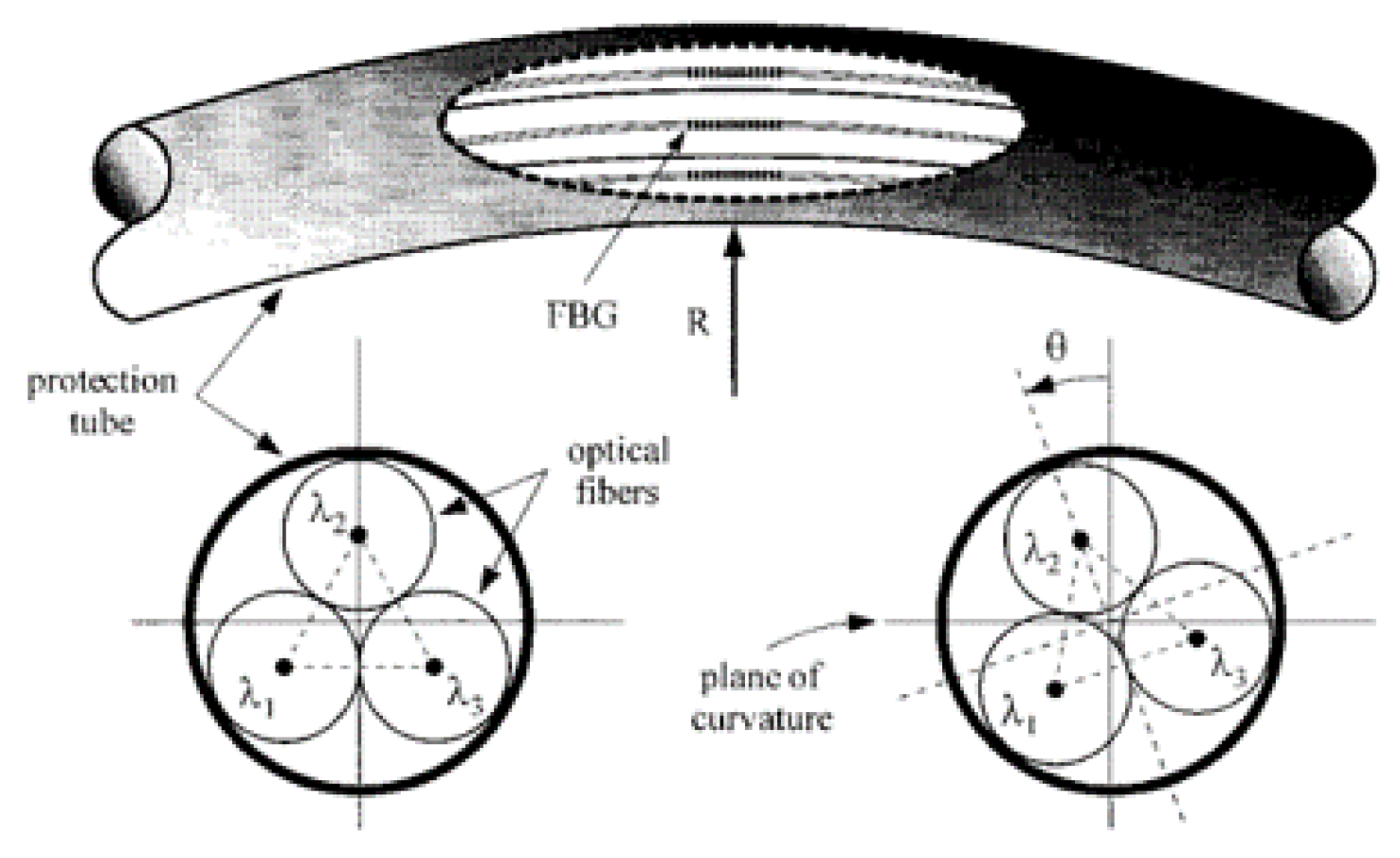
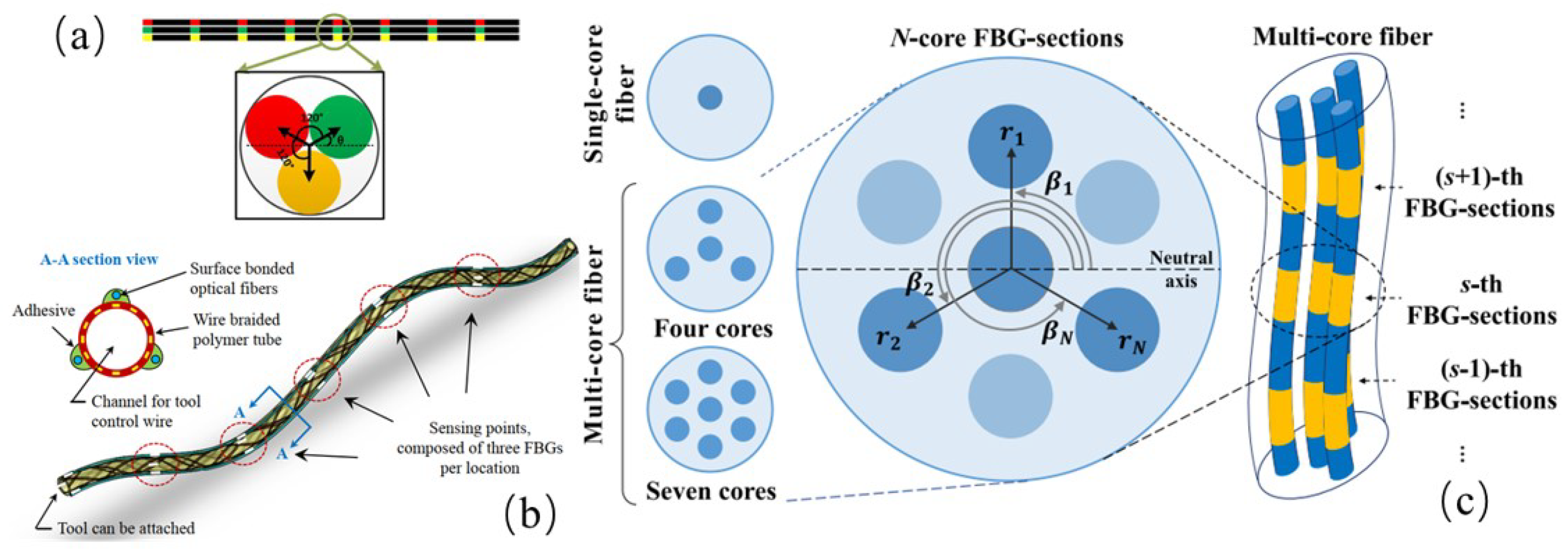

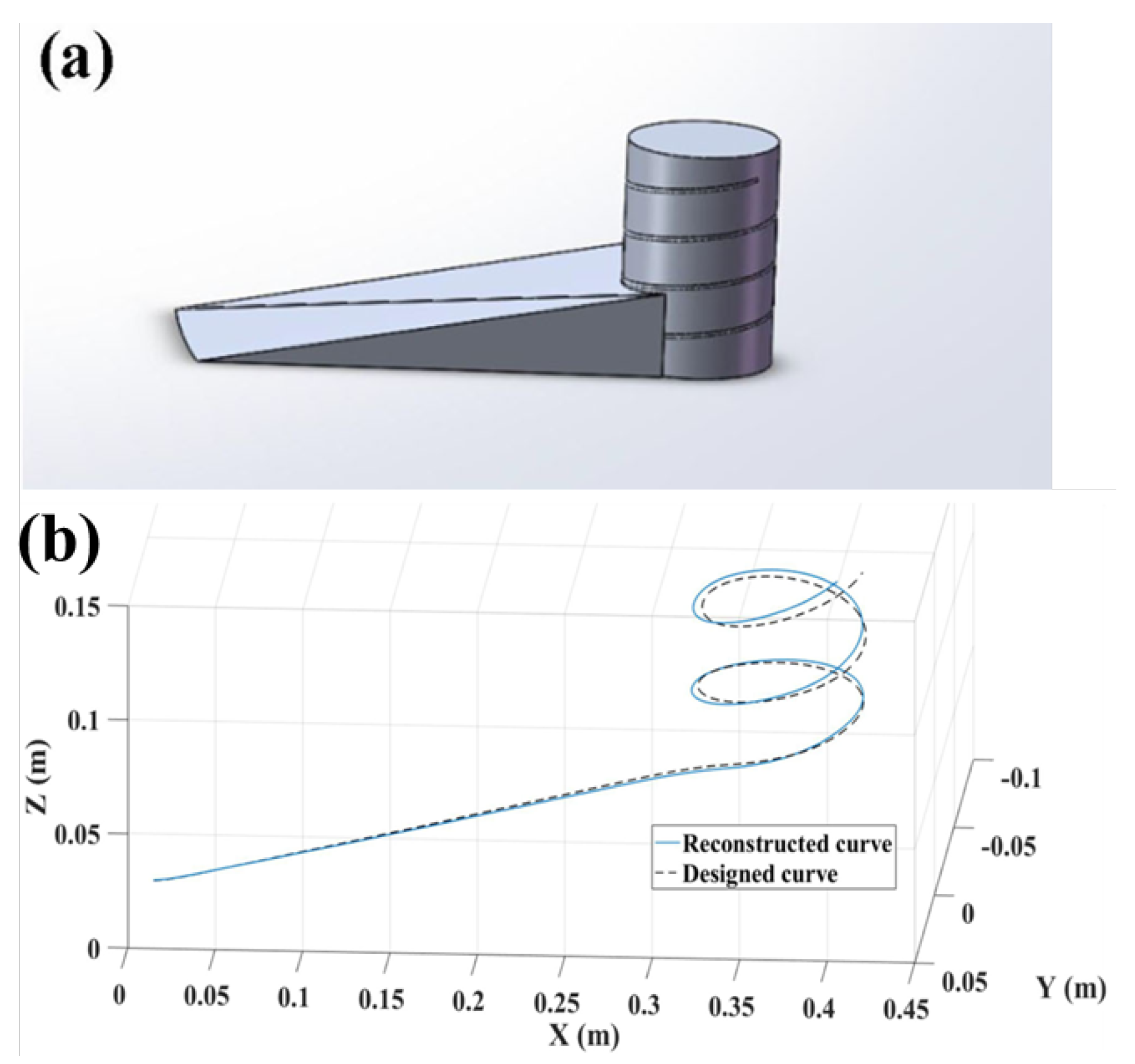
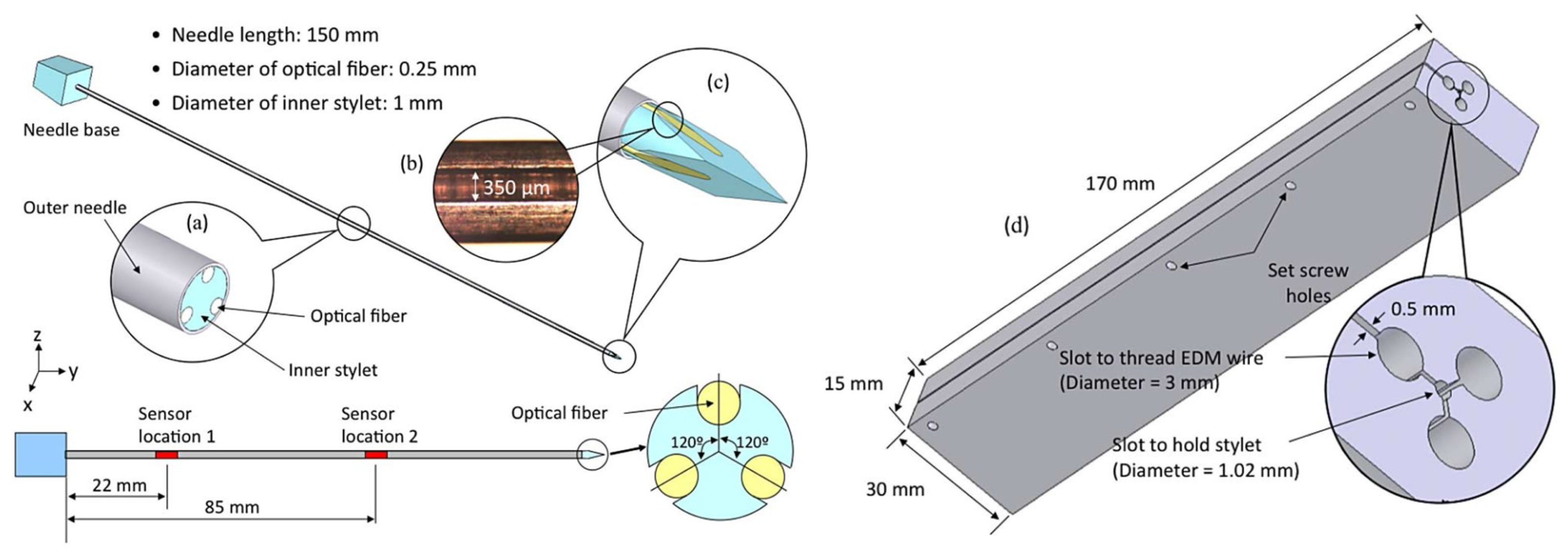

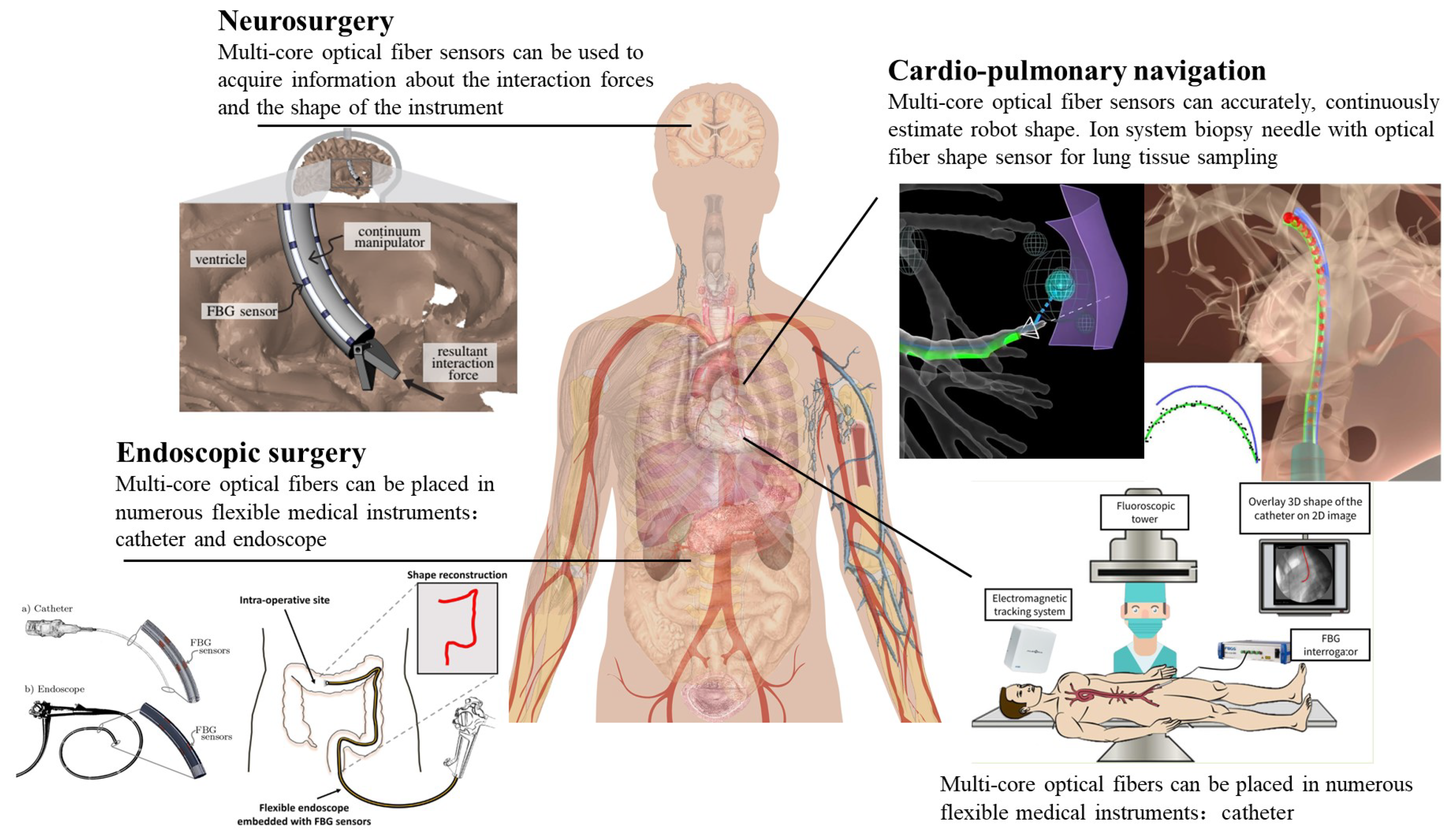

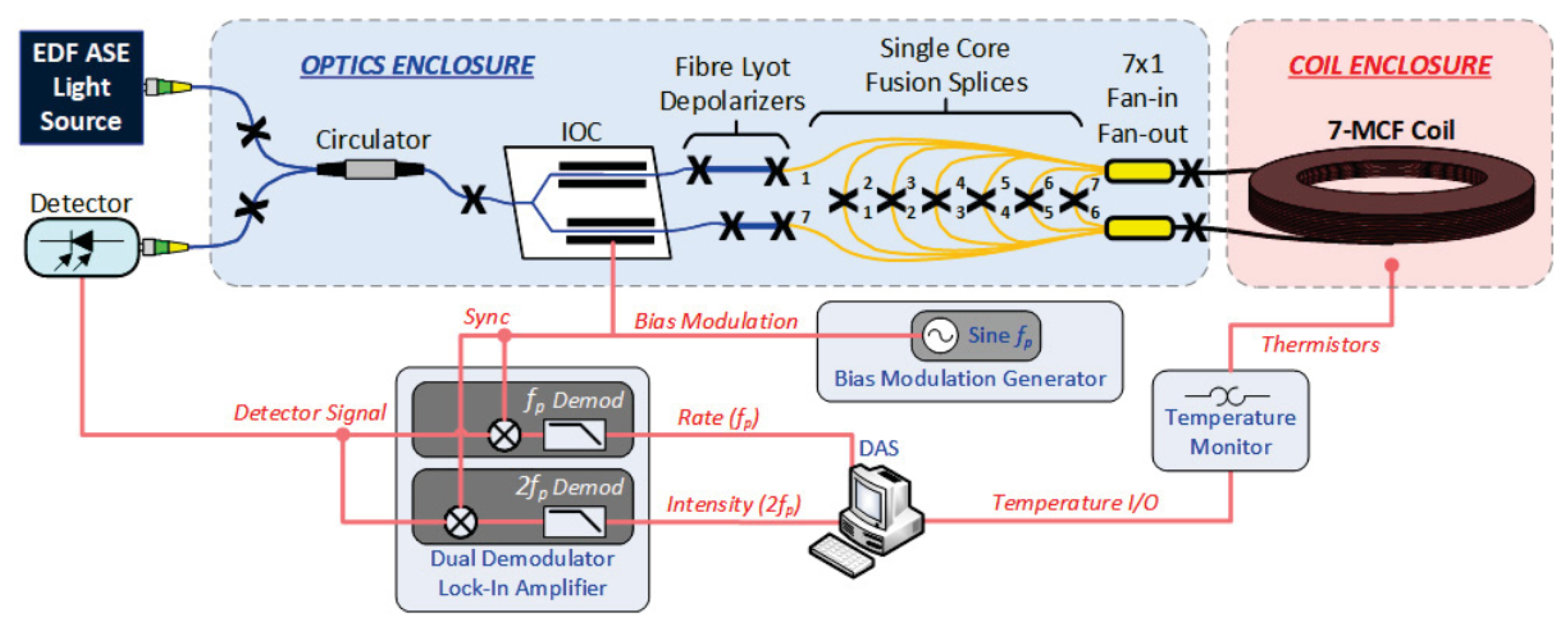


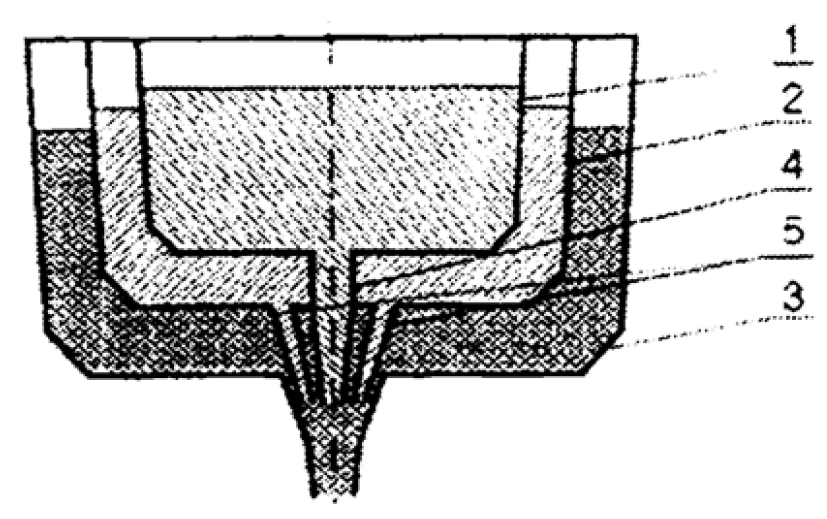
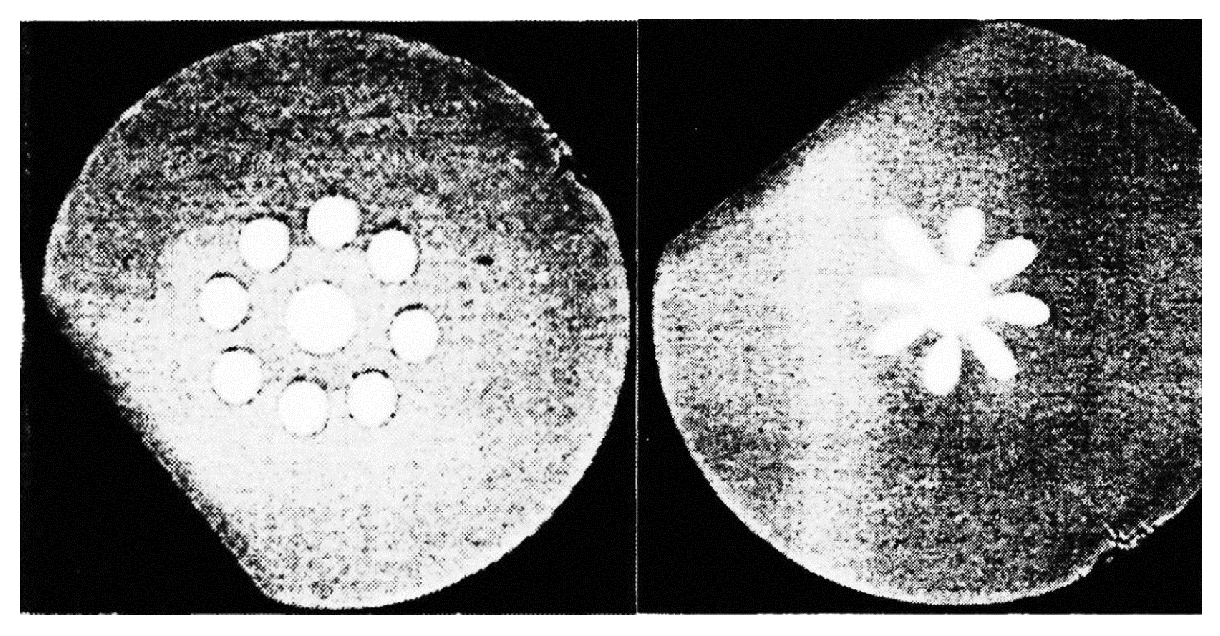
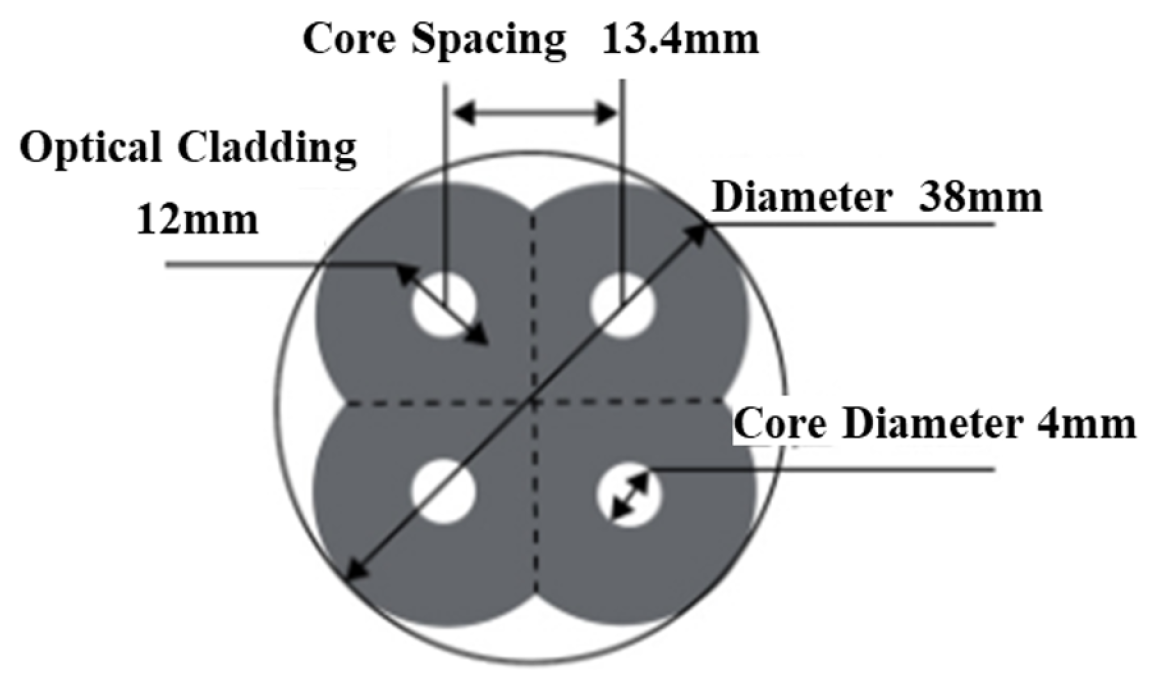
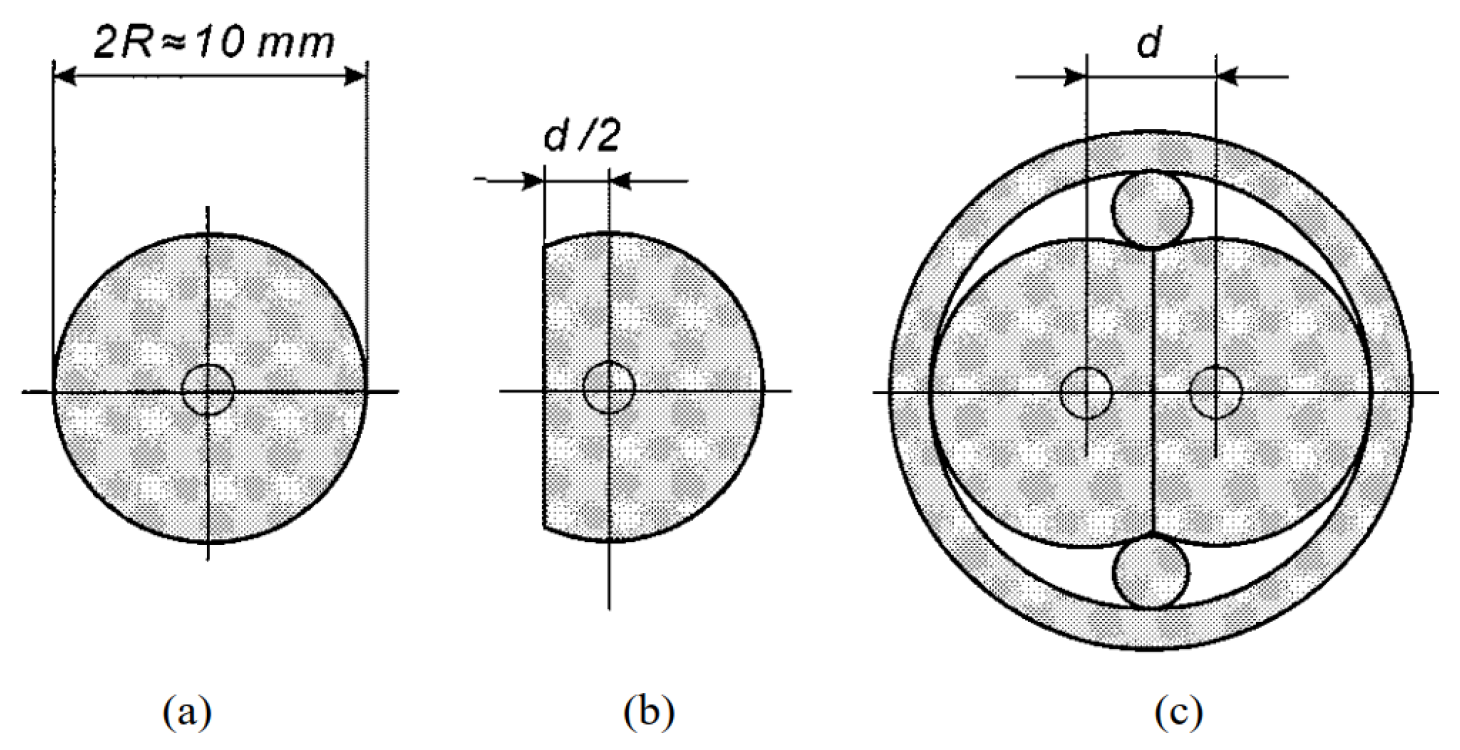


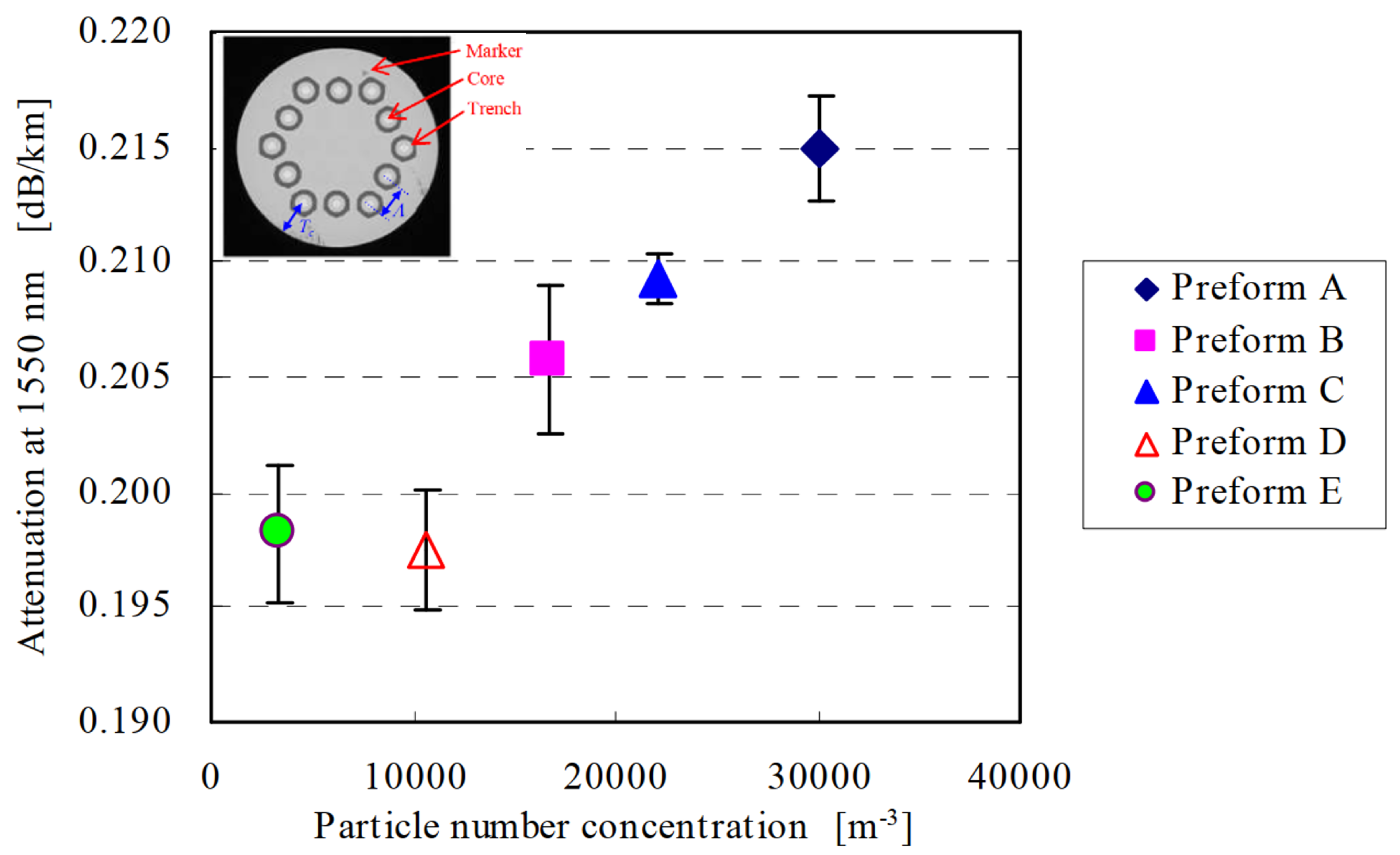
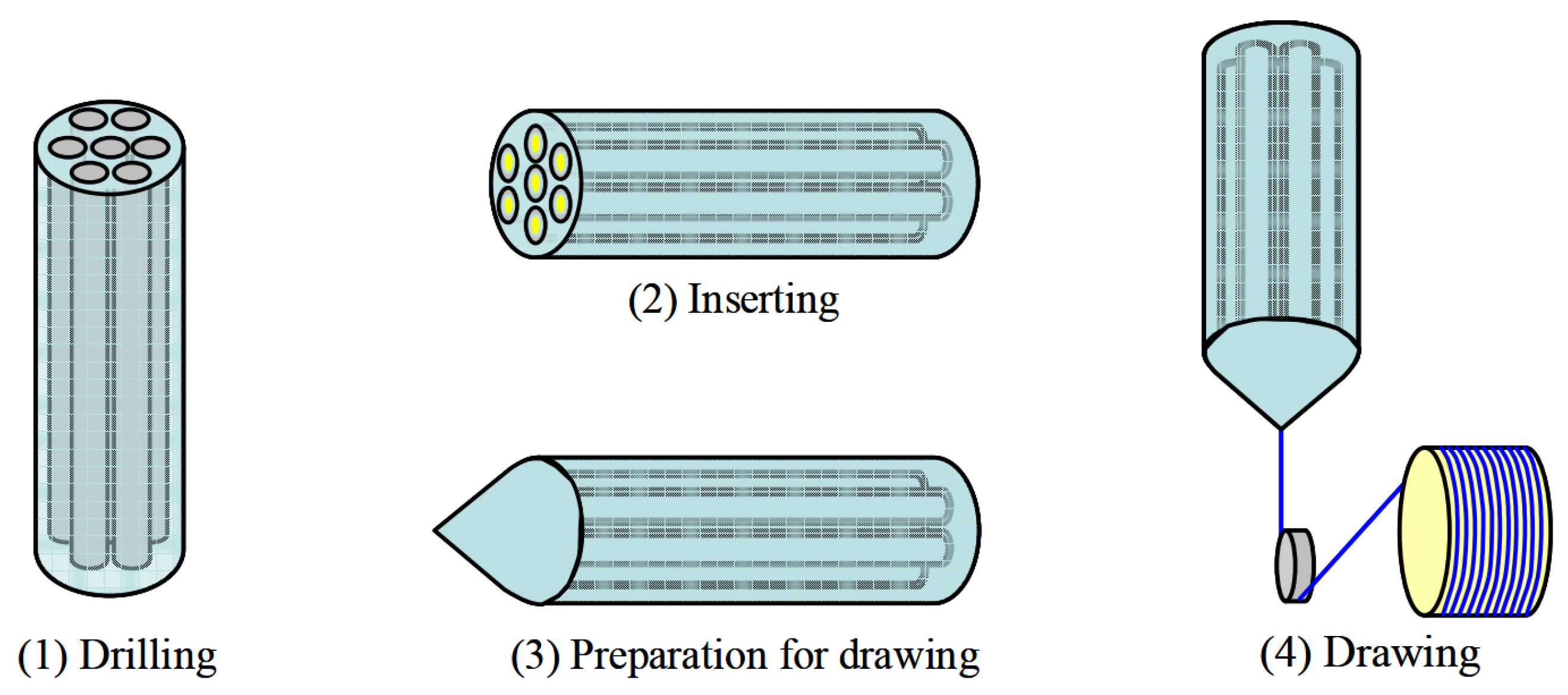

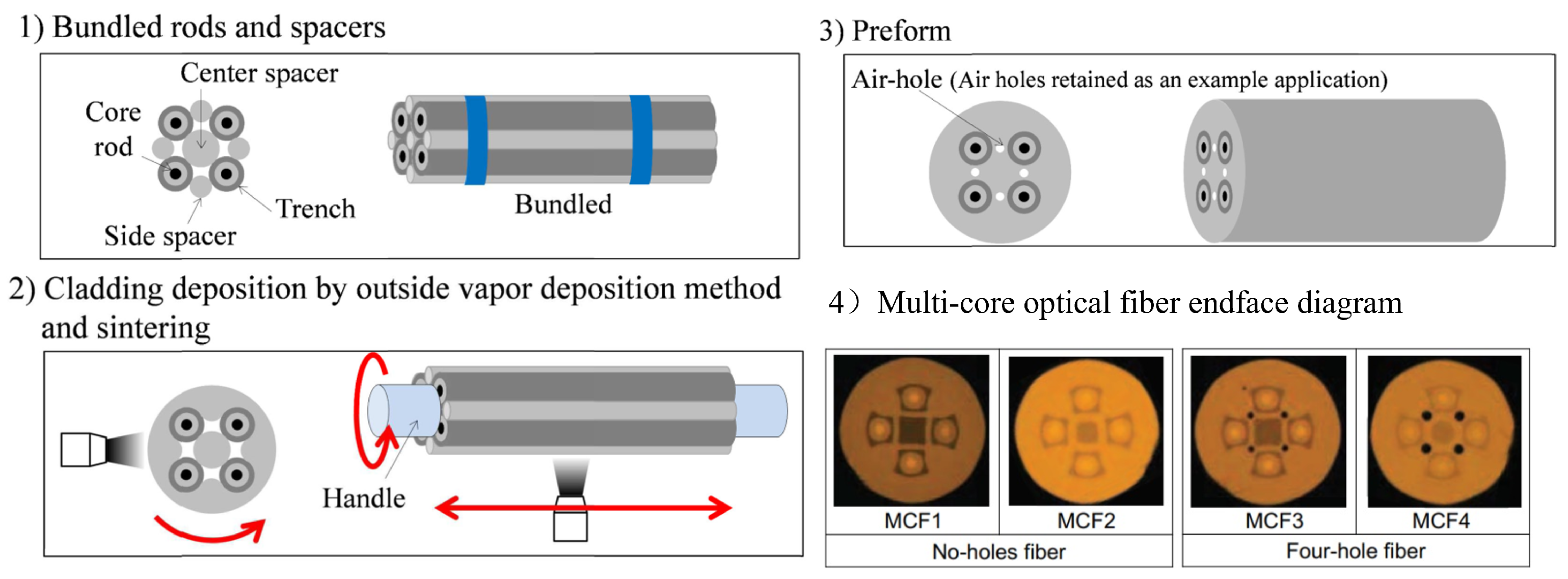

| Application | Importance of Key Parameters | ||||
|---|---|---|---|---|---|
| Attenuation | Crosstalk | Bend Loss | Effective Area | Core-to-Core Distance Precision | |
| Optical Communication | ★★★ | ★★★ | ★★★ | ★★★ | ★ |
| Optical Sensing | ★ | ★★★ | ★★★ | ★ | ★ |
| Fiber Lasers | ★★ | ★★ | ★★★ | ★★★ | ★ |
| Year | Core Count | Attenuation (dB/km) | |Crosstalk| | Fiber Core Spacing | End Face | Reference |
|---|---|---|---|---|---|---|
| 2010 | 7 | 0.25 | 17 dB/2 km | 40 m |  | [147] |
| 2011 | 7 | 0.21 | 35 dB/100 km | 38.3 m |  | [148] |
| 2011 | 7 | 0.171 | 37.7 dB/100 km | 45 m |  | [46] |
| 2014 | 12 | 0.2 | 50.6 dB/100 km | 44.5 m |  | [153] |
| 2016 | 16 | 0.2 | 40.5 dB/55 km | 37.5 m |  | [174] |
| 2017 | 37 | 0.241 | 20 dB/1000 km | 29.1 m |  | [182] |
Disclaimer/Publisher’s Note: The statements, opinions and data contained in all publications are solely those of the individual author(s) and contributor(s) and not of MDPI and/or the editor(s). MDPI and/or the editor(s) disclaim responsibility for any injury to people or property resulting from any ideas, methods, instructions or products referred to in the content. |
© 2024 by the authors. Licensee MDPI, Basel, Switzerland. This article is an open access article distributed under the terms and conditions of the Creative Commons Attribution (CC BY) license (https://creativecommons.org/licenses/by/4.0/).
Share and Cite
Chen, W.; Yuan, L.; Zhang, B.; Yu, Q.; Lian, Z.; Pi, Y.; Shan, C.; Shum, P.P. Applications and Development of Multi-Core Optical Fibers. Photonics 2024, 11, 270. https://doi.org/10.3390/photonics11030270
Chen W, Yuan L, Zhang B, Yu Q, Lian Z, Pi Y, Shan C, Shum PP. Applications and Development of Multi-Core Optical Fibers. Photonics. 2024; 11(3):270. https://doi.org/10.3390/photonics11030270
Chicago/Turabian StyleChen, Weiping, Lei Yuan, Bo Zhang, Qianqin Yu, Zhenggang Lian, Yabin Pi, Chongxin Shan, and Perry Ping Shum. 2024. "Applications and Development of Multi-Core Optical Fibers" Photonics 11, no. 3: 270. https://doi.org/10.3390/photonics11030270
APA StyleChen, W., Yuan, L., Zhang, B., Yu, Q., Lian, Z., Pi, Y., Shan, C., & Shum, P. P. (2024). Applications and Development of Multi-Core Optical Fibers. Photonics, 11(3), 270. https://doi.org/10.3390/photonics11030270









